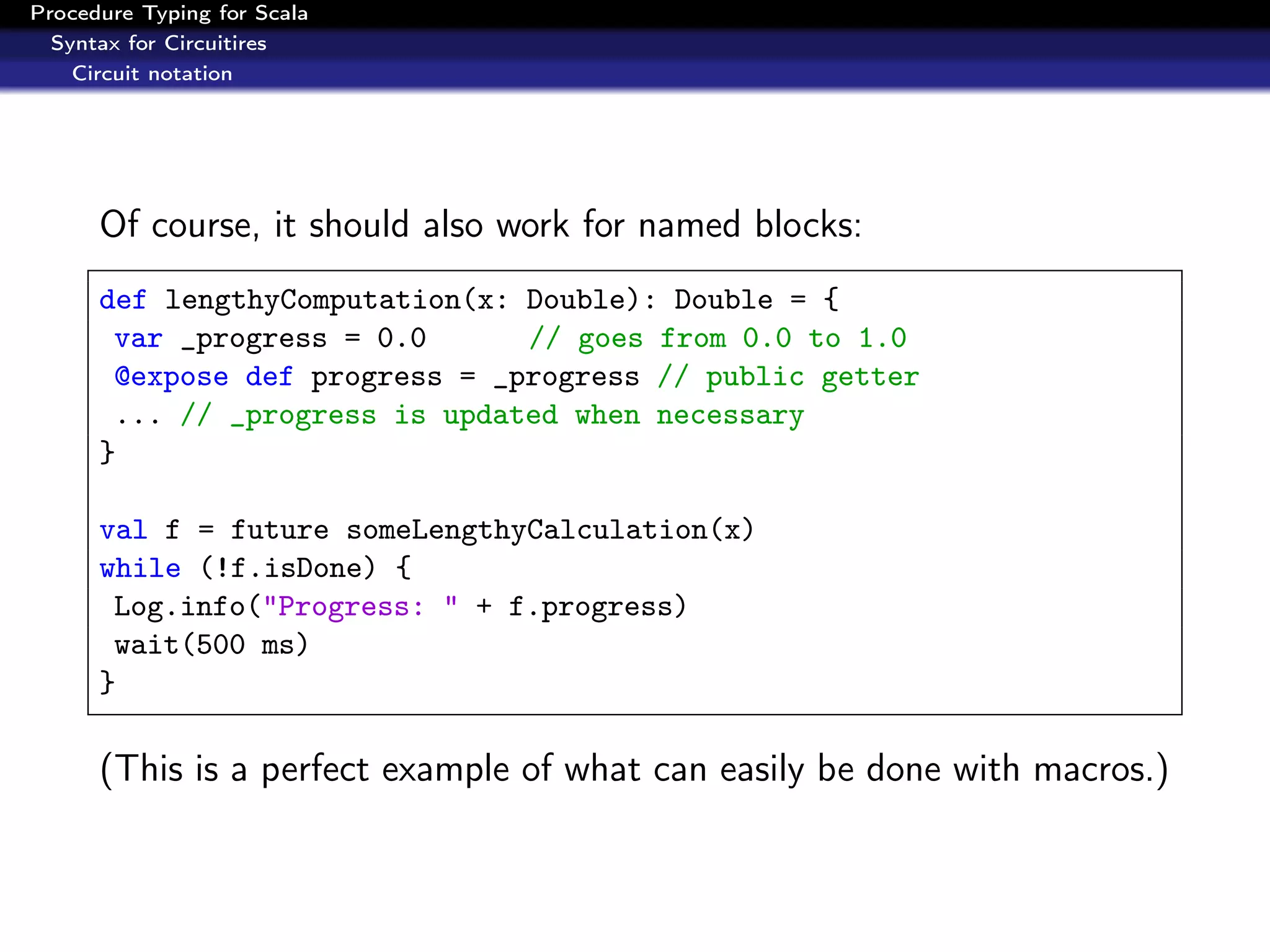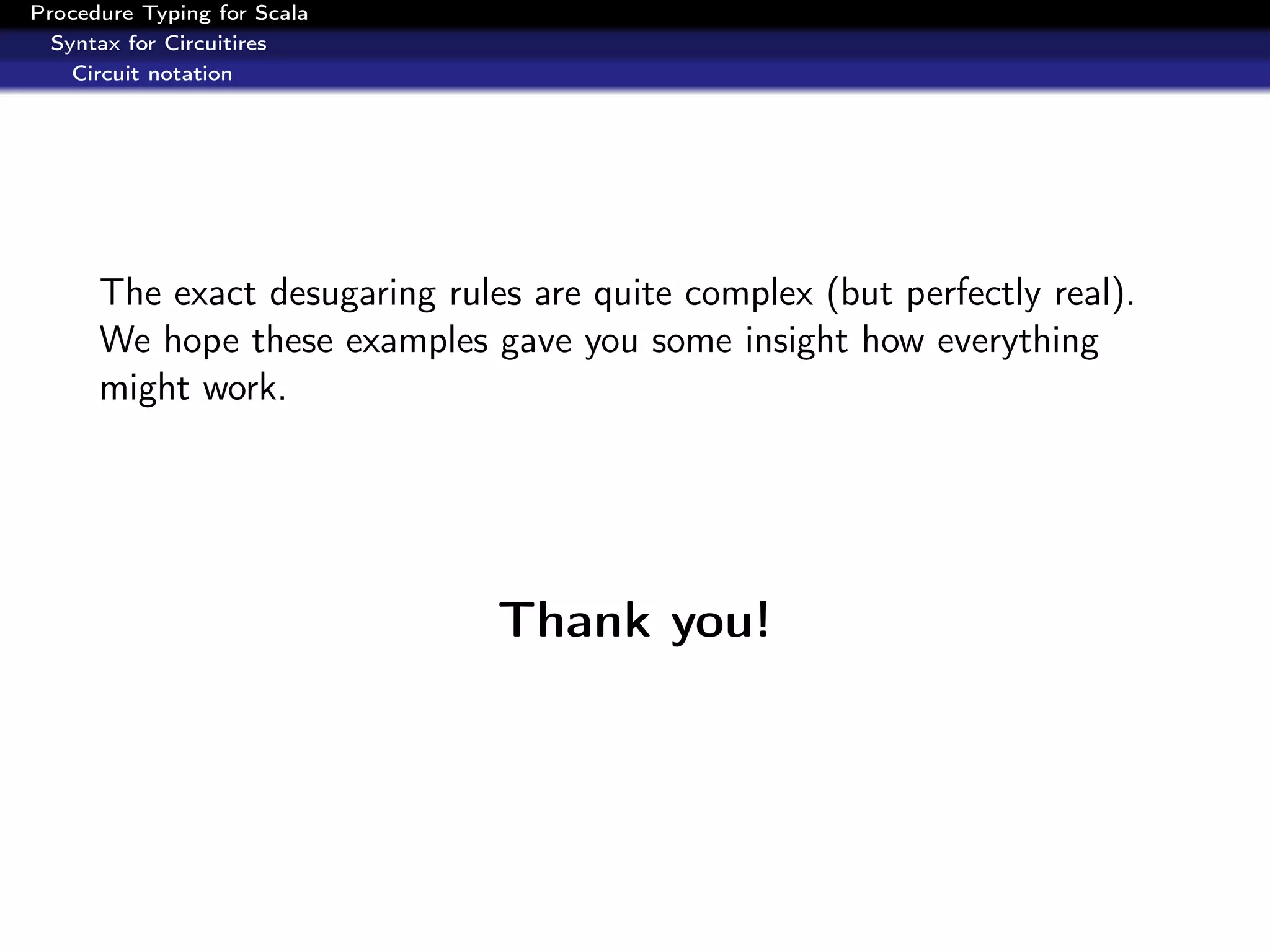The document discusses a proposed system of procedure typing for Scala, which emphasizes the importance of distinguishing between pure functions and procedures. It introduces a new syntax for defining procedure categories and outlines methodologies for static side effect tracking, enabling compile-time detection of various issues like race conditions and deadlocks. Additionally, it proposes a modularization program to purify the Scala language by implementing a lattice of procedure categories and optimizing flow control mechanisms.
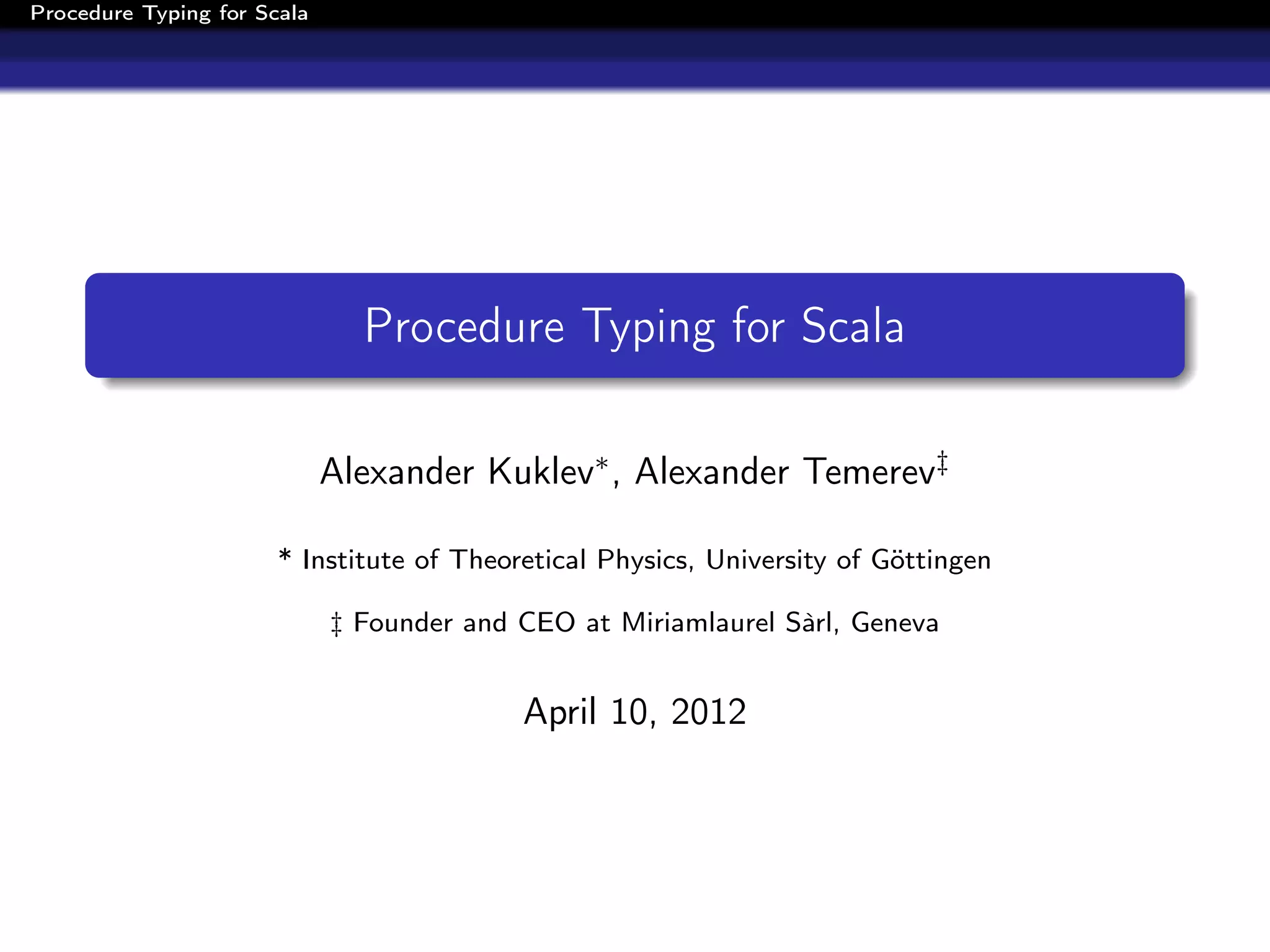
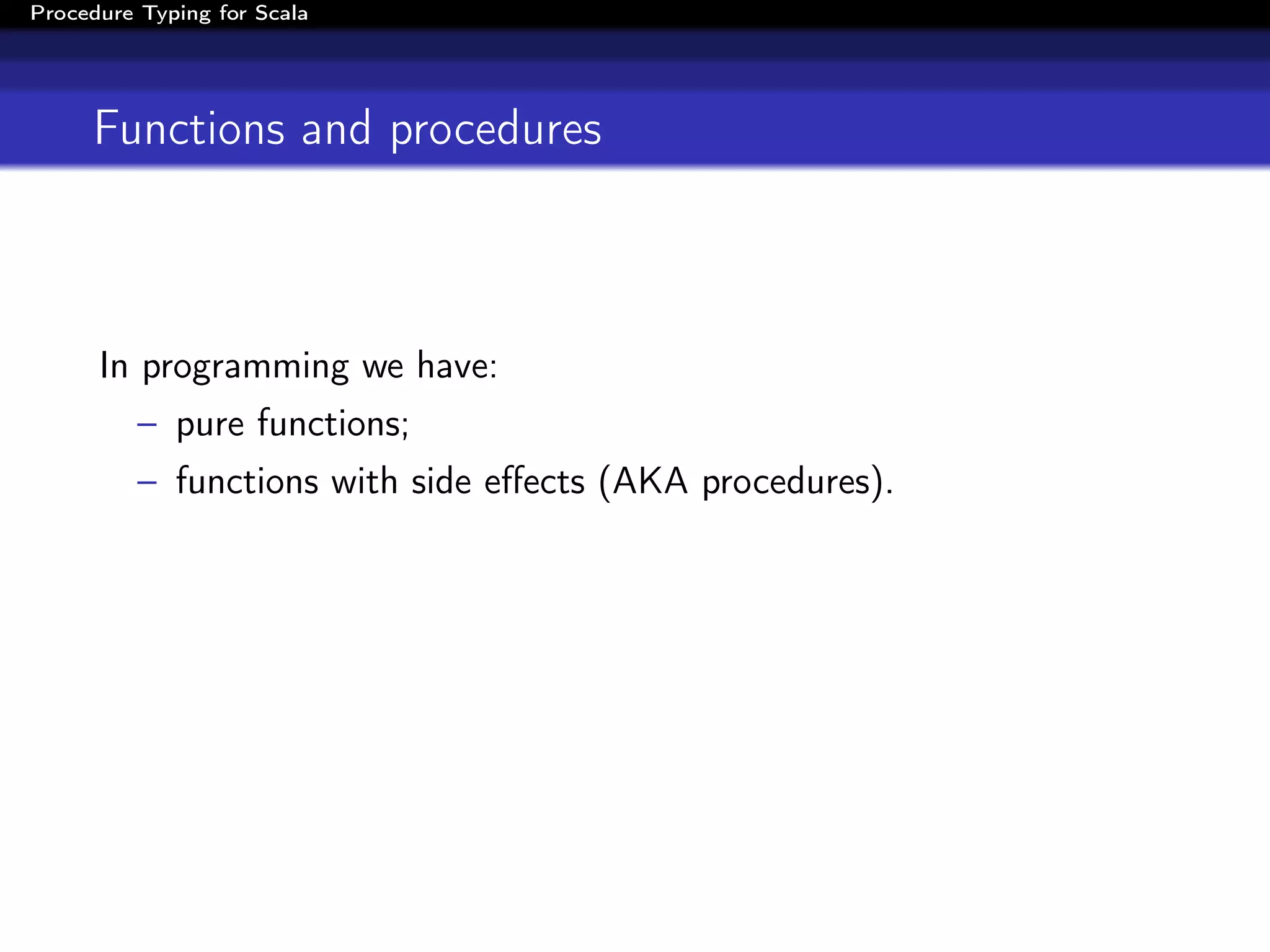
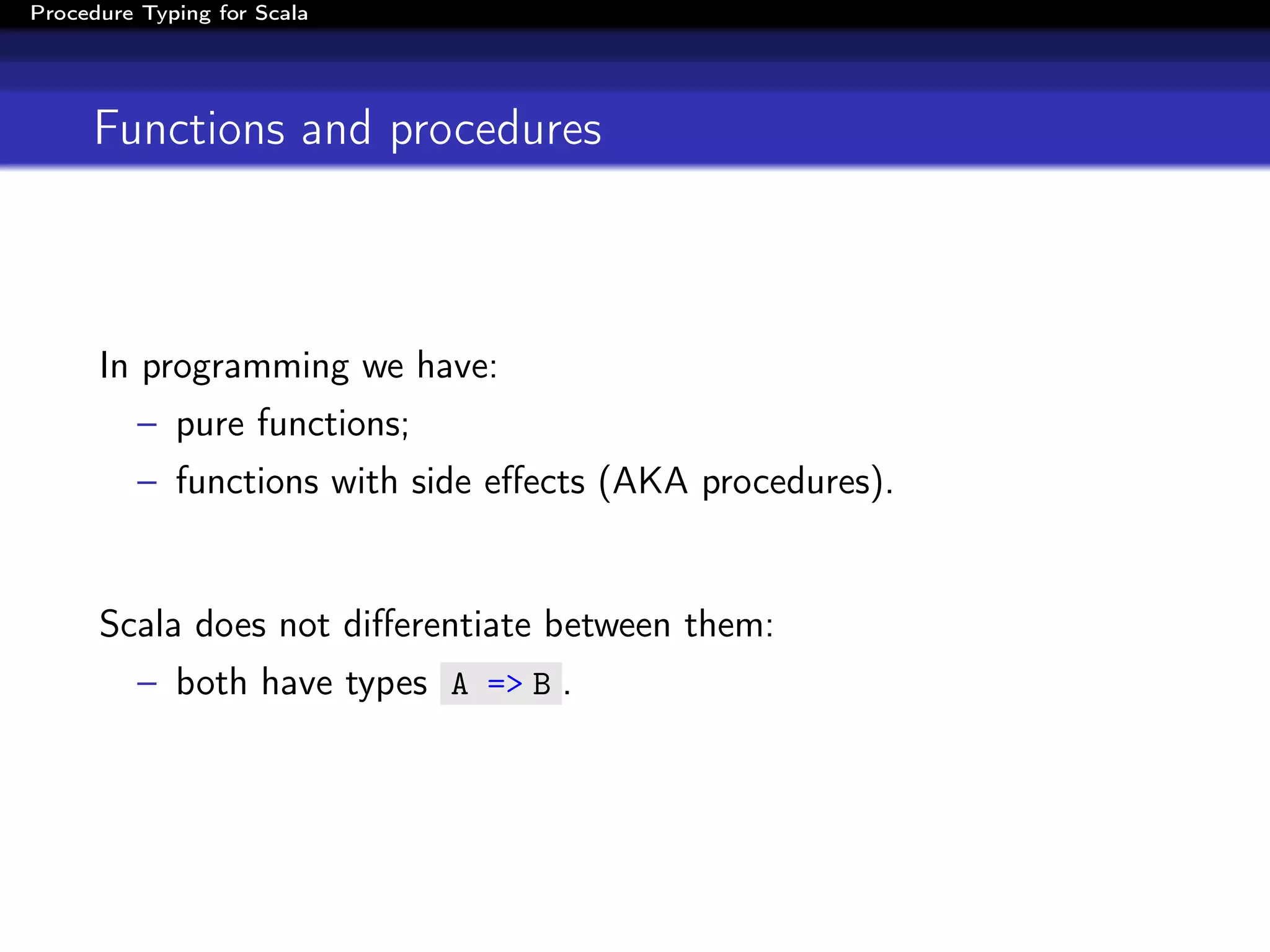
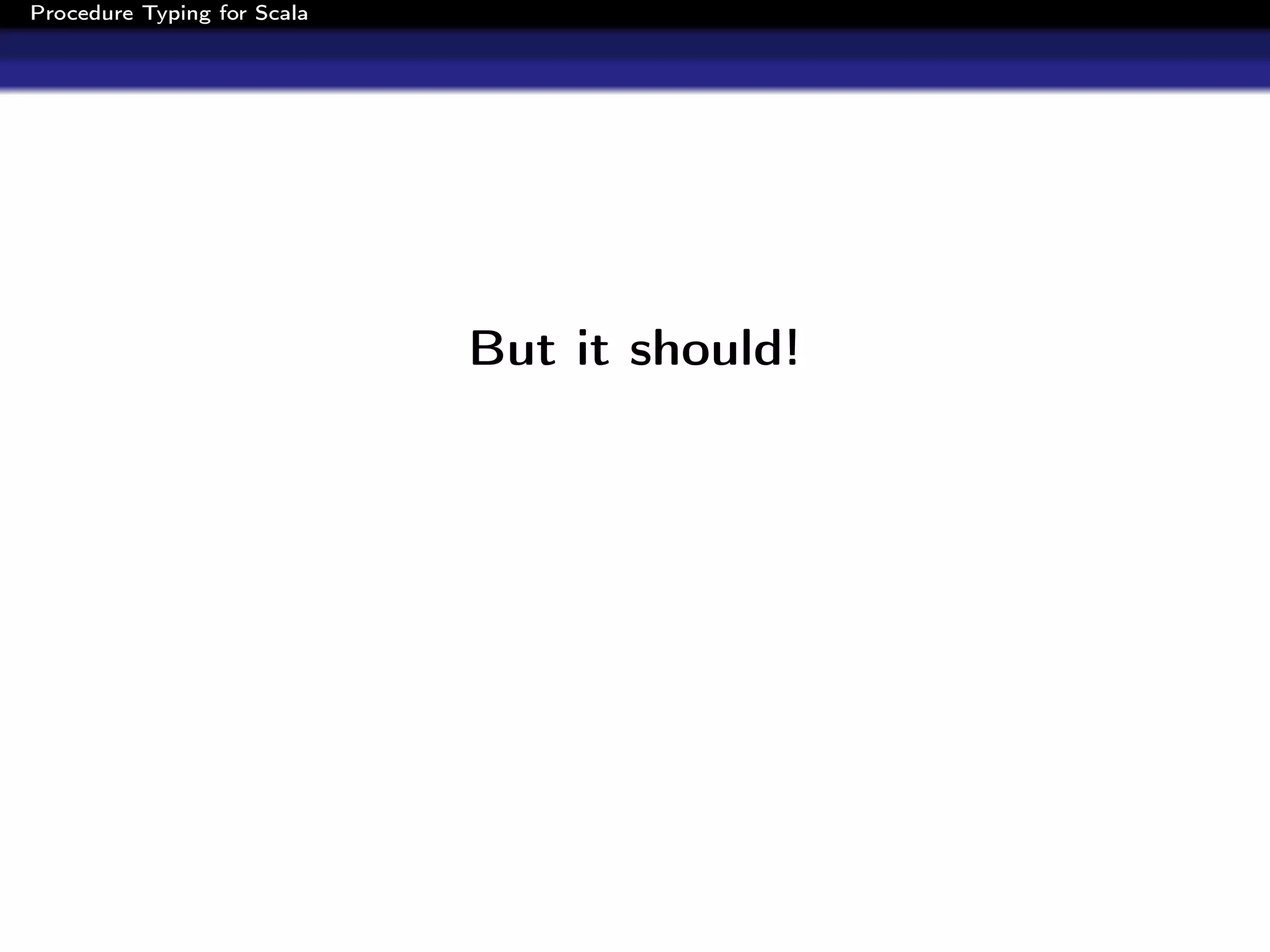
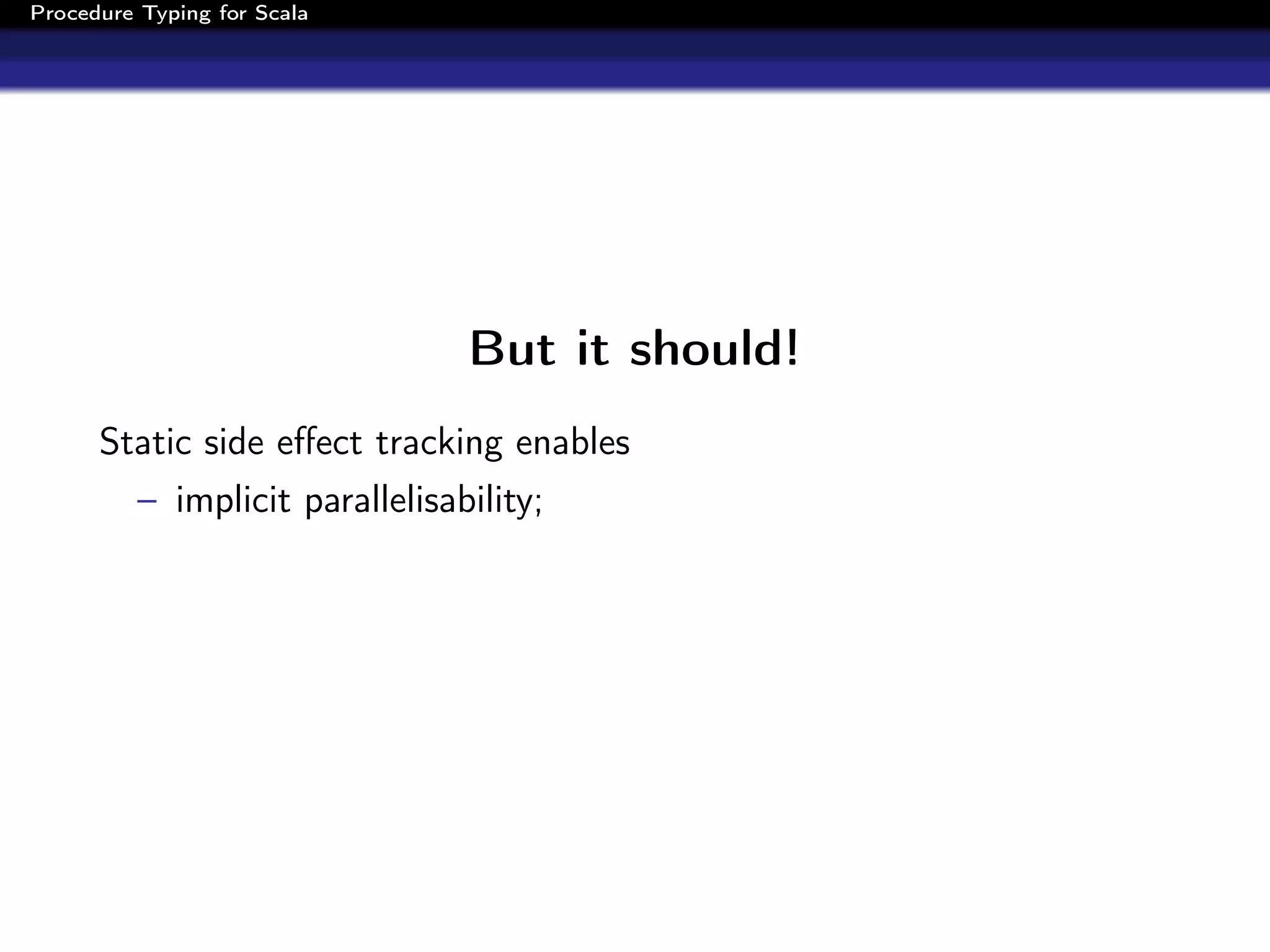
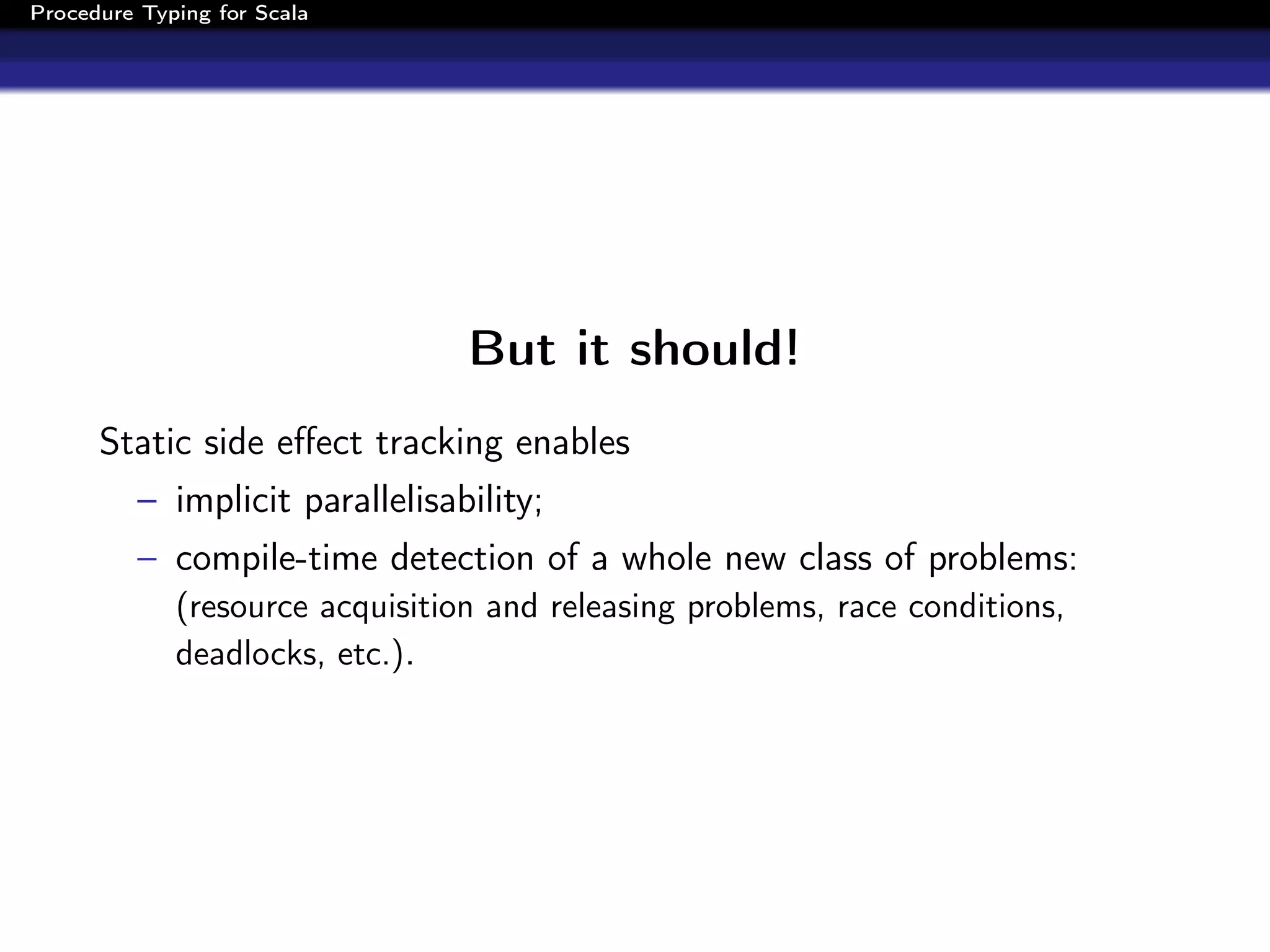
![Procedure Typing for Scala
Short list of applicable methodologies:
Kleisli Arrows of Outrageous Fortune (2011, C. McBride)
Capabilities for Uniqueness and Borrowing (2010, P. Haller, M. Odersky)
Static Detection of Race Conditions [..] (2010, M. Christakis, K. Sagonas)
Static Deadlock Detection [..] (2009, F. de Boer, I. Grabe,M. Steffen)
Complete Behavioural Testing of Object-Oriented Systems using
CCS-Augmented X-Machines (2002, M. Stannett, A. J. H. Simons)
An integration testing method that is proved to find all faults
(1997, F. Ipate, M. Holcombe)](https://image.slidesharecdn.com/scala-circuitries-120408102919-phpapp02/75/Procedure-Typing-for-Scala-7-2048.jpg)
![Procedure Typing for Scala
Specifying procedure categories
We propose a new syntax
where a function definition may include a category it belongs to:
A =>[Pure] B – pure functions;
A =>[Proc] B – procedures.](https://image.slidesharecdn.com/scala-circuitries-120408102919-phpapp02/75/Procedure-Typing-for-Scala-8-2048.jpg)
![Procedure Typing for Scala
Specifying procedure categories
There’s a lot more than Pure and Proc
There is a whole lattice of categories between Pure and Proc :
Logged: procedures with no side effects besides logging;
Throws[E]: no side effects besides throwing exceptions of type E ;
Reads(file): no side effects besides reading the file ;
etc.](https://image.slidesharecdn.com/scala-circuitries-120408102919-phpapp02/75/Procedure-Typing-for-Scala-9-2048.jpg)
![Procedure Typing for Scala
Specifying procedure categories
Extensible approach
An effect system should be extensible.
⇒ We must provide a way to define procedure categories.
Procedure categories are binary types like Function[_,_] or
Logged[_,_] 1
1
Definition of parameterized categories, e.g. Throws[E] or Reads(resource),
is also possible with the help of type lambdas and/or type providers.](https://image.slidesharecdn.com/scala-circuitries-120408102919-phpapp02/75/Procedure-Typing-for-Scala-10-2048.jpg)
![Procedure Typing for Scala
Specifying procedure categories
Extensible approach
An effect system should be extensible.
⇒ We must provide a way to define procedure categories.
Procedure categories are binary types like Function[_,_] or
Logged[_,_] 1 equipped with some additional structure using an
associated type class.
1
Definition of parameterized categories, e.g. Throws[E] or Reads(resource),
is also possible with the help of type lambdas and/or type providers.](https://image.slidesharecdn.com/scala-circuitries-120408102919-phpapp02/75/Procedure-Typing-for-Scala-11-2048.jpg)
![Procedure Typing for Scala
Specifying procedure categories
Extensible approach
Syntax details
– A =>[R] B R[A,B]
– A => B Function[A,B] , i.e. type named “Function” from the
local context, not necessarily the Function from Predef2 .
2
(A, B) should also mean Pair[A,B] from the local context, as they
must be consistent with functions: (A, B) => C ∼ A => B => C .
=](https://image.slidesharecdn.com/scala-circuitries-120408102919-phpapp02/75/Procedure-Typing-for-Scala-12-2048.jpg)
![Procedure Typing for Scala
Specifying procedure categories
Extensible approach
Proposed syntax for definitions
def process(d: Data):
=>[Throws[InterruptedException]] Int = { ...
// Procedure types can be dependent
def copy(src: File, dest: File):
=>[Reads(src), Writes(dest)] { ...
// Pre- and postconditions can be treated as effects too:
def open(file: File):
=>[Pre{file@Closed}, Post{file@Open}] { ...
Last two examples rely on recently added dependent method types.
(N.B. Such stunts are hard to implement using type-and-effect systems.)](https://image.slidesharecdn.com/scala-circuitries-120408102919-phpapp02/75/Procedure-Typing-for-Scala-13-2048.jpg)
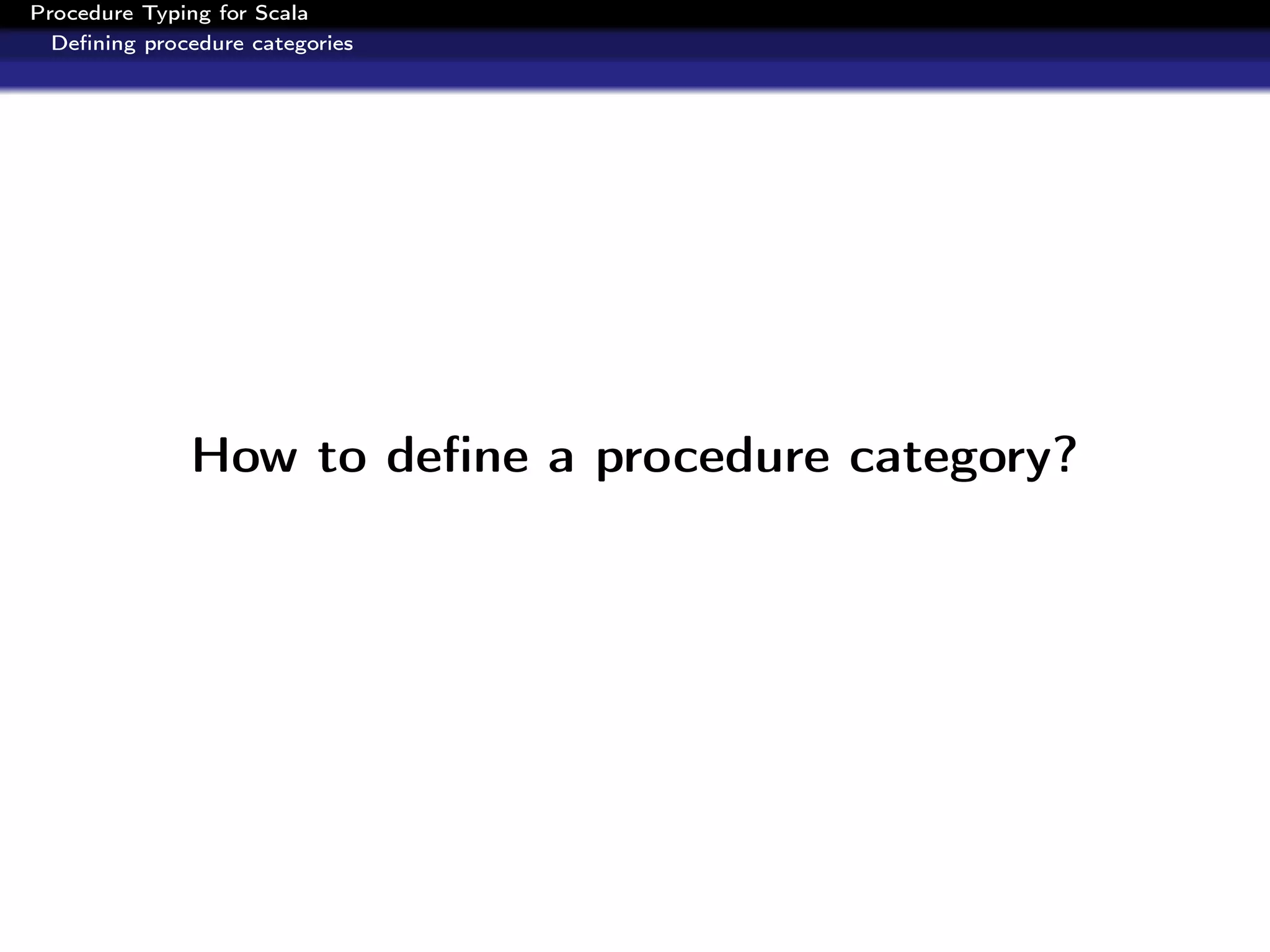
![Procedure Typing for Scala
Defining procedure categories
First of all, it should be a category in the usual mathematical sense,
i.e. we have to provide procedure composition and its neutral.
trait Category[Function[_,_]] {
def id[T]: T => T
def compose[A, B, C](f: B => C, g: A => B): A => C
}](https://image.slidesharecdn.com/scala-circuitries-120408102919-phpapp02/75/Procedure-Typing-for-Scala-15-2048.jpg)
![Procedure Typing for Scala
Defining procedure categories
To give an example, let’s model logged functions on pure functions:
type Logged[A, B] = (A =>[Pure] (B, String))
object Logged extends Category[Logged] {
def id[T] = {x: T => (x, "")}
def compose[A, B, C](f: B => C, g: A => B) = {x: A =>
val (result1, logOutput1) = g(x)
val (result2, logOutput2) = f(result1)
(result2, logOutput1 + logOutput2)
}
}
Besides their results, logged functions produce log output of type
String. Composition of logged functions concatenates their logs.](https://image.slidesharecdn.com/scala-circuitries-120408102919-phpapp02/75/Procedure-Typing-for-Scala-16-2048.jpg)
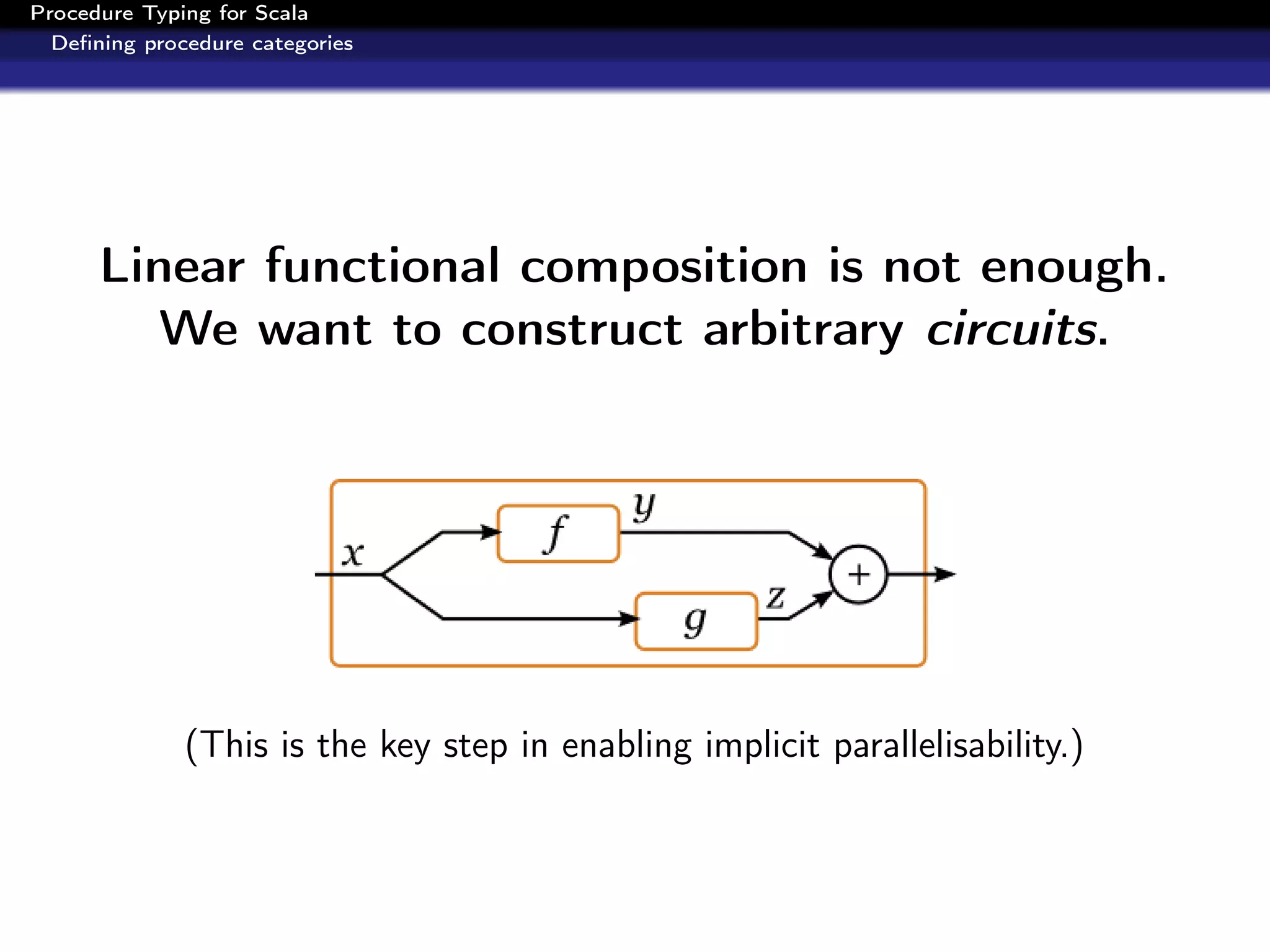
: (A, C) => (B, D)](https://image.slidesharecdn.com/scala-circuitries-120408102919-phpapp02/75/Procedure-Typing-for-Scala-18-2048.jpg)
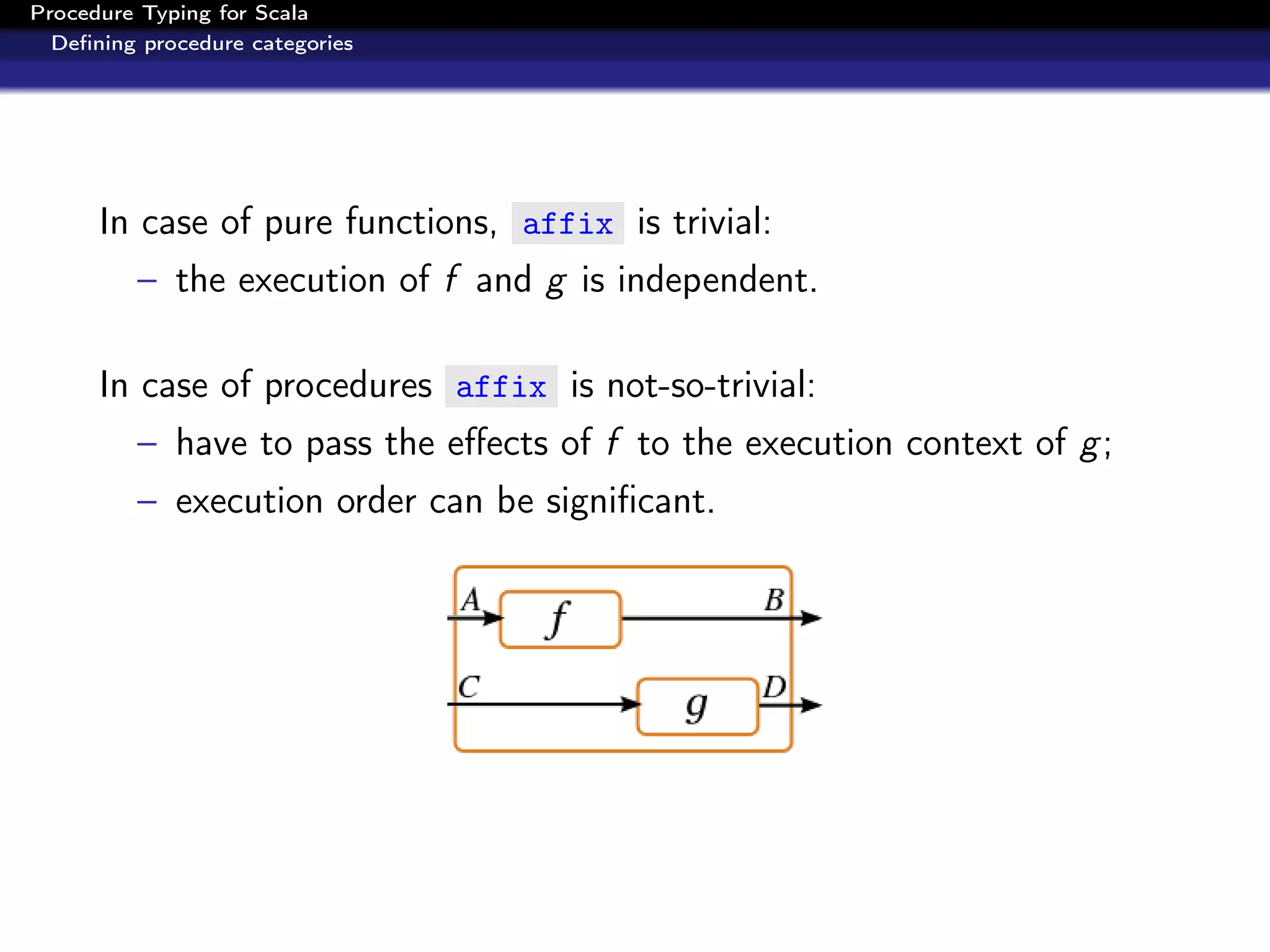
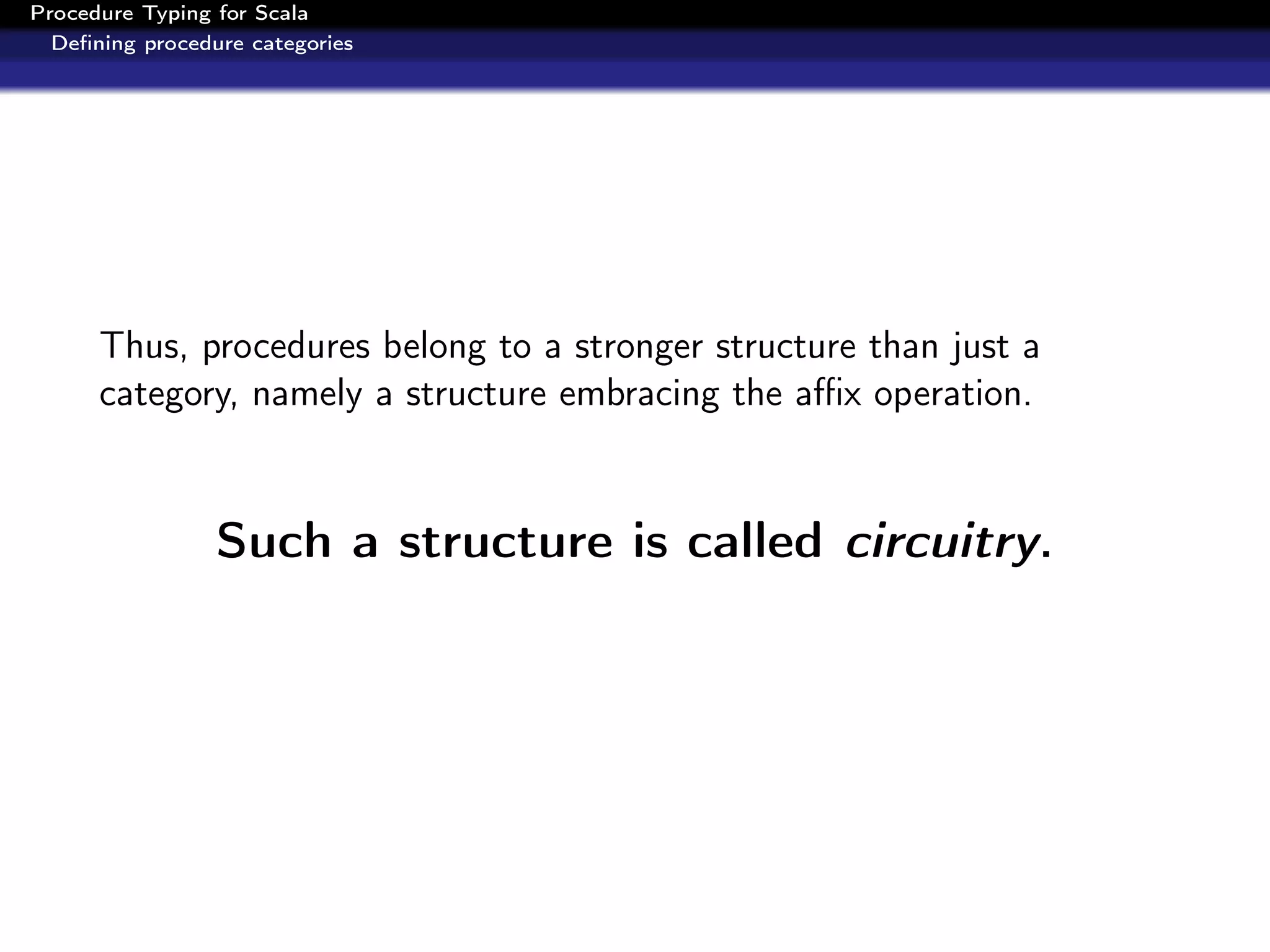
![Procedure Typing for Scala
Defining procedure categories
A circuitry is a closed monoidal category with respect to the affix
operation, where affix splits as follows:
trait Circuitry[F[_,_]] extends PairCategory[F] {
def passr[A, B, C](f: A => B): (A, C) => (B, C)
def passl[B, C, D](g: C => D): (B, C) => (B, D)
override def affix[A, B, C, D](f: A => B, g: C => D) = {
compose(passl(g), passr(f))
}
}
+ =](https://image.slidesharecdn.com/scala-circuitries-120408102919-phpapp02/75/Procedure-Typing-for-Scala-21-2048.jpg)
![Procedure Typing for Scala
Defining procedure categories
For the mathematicians among us:
trait PairCategory[F[_,_]] extends Category[F] {
type Pair[A, B]
def assoc[X, Y, Z]: ((X, Y), Z) => (X, (Y, Z))
def unassoc[X, Y, Z]: (X, (Y, Z)) => ((X, Y), Z)
type Unit
def cancelr[X]: (X, Unit) => X
def cancell[X]: (Unit, X) => X
def uncancelr[X]: X => (X, Unit)
def uncancell[X]: X => (Unit, X)
def curry[A, B, C](f: (A, B) => C): A => B => C
def uncurry[A, B, C](f: A => B => C): (A, B) => C
def affix[A, B, C, D](f: A => B, g: C => D): (A, B) => (C, D)
}](https://image.slidesharecdn.com/scala-circuitries-120408102919-phpapp02/75/Procedure-Typing-for-Scala-22-2048.jpg)
![Procedure Typing for Scala
Defining procedure categories
For the mathematicians among us:
trait PairCategory[F[_,_]] extends Category[F] {
type Pair[A, B]
def assoc[X, Y, Z]: ((X, Y), Z) => (X, (Y, Z))
def unassoc[X, Y, Z]: (X, (Y, Z)) => ((X, Y), Z)
type Unit
def cancelr[X]: (X, Unit) => X
def cancell[X]: (Unit, X) => X
def uncancelr[X]: X => (X, Unit)
def uncancell[X]: X => (Unit, X)
def curry[A, B, C](f: (A, B) => C): A => B => C
def uncurry[A, B, C](f: A => B => C): (A, B) => C
def affix[A, B, C, D](f: A => B, g: C => D): (A, B) => (C, D)
}
Don’t panic!](https://image.slidesharecdn.com/scala-circuitries-120408102919-phpapp02/75/Procedure-Typing-for-Scala-23-2048.jpg)
![Procedure Typing for Scala
Defining procedure categories
For the mathematicians among us:
trait PairCategory[F[_,_]] extends Category[F] {
type Pair[A, B]
def assoc[X, Y, Z]: ((X, Y), Z) => (X, (Y, Z))
def unassoc[X, Y, Z]: (X, (Y, Z)) => ((X, Y), Z)
type Unit
def cancelr[X]: (X, Unit) => X
def cancell[X]: (Unit, X) => X
def uncancelr[X]: X => (X, Unit)
def uncancell[X]: X => (Unit, X)
def curry[A, B, C](f: (A, B) => C): A => B => C
def uncurry[A, B, C](f: A => B => C): (A, B) => C
def affix[A, B, C, D](f: A => B, g: C => D): (A, B) => (C, D)
}
Don’t panic!
In most cases the default Pair and Unit work perfectly well.
⇒ No need to understand any of this, just use with Cartesian .](https://image.slidesharecdn.com/scala-circuitries-120408102919-phpapp02/75/Procedure-Typing-for-Scala-24-2048.jpg)
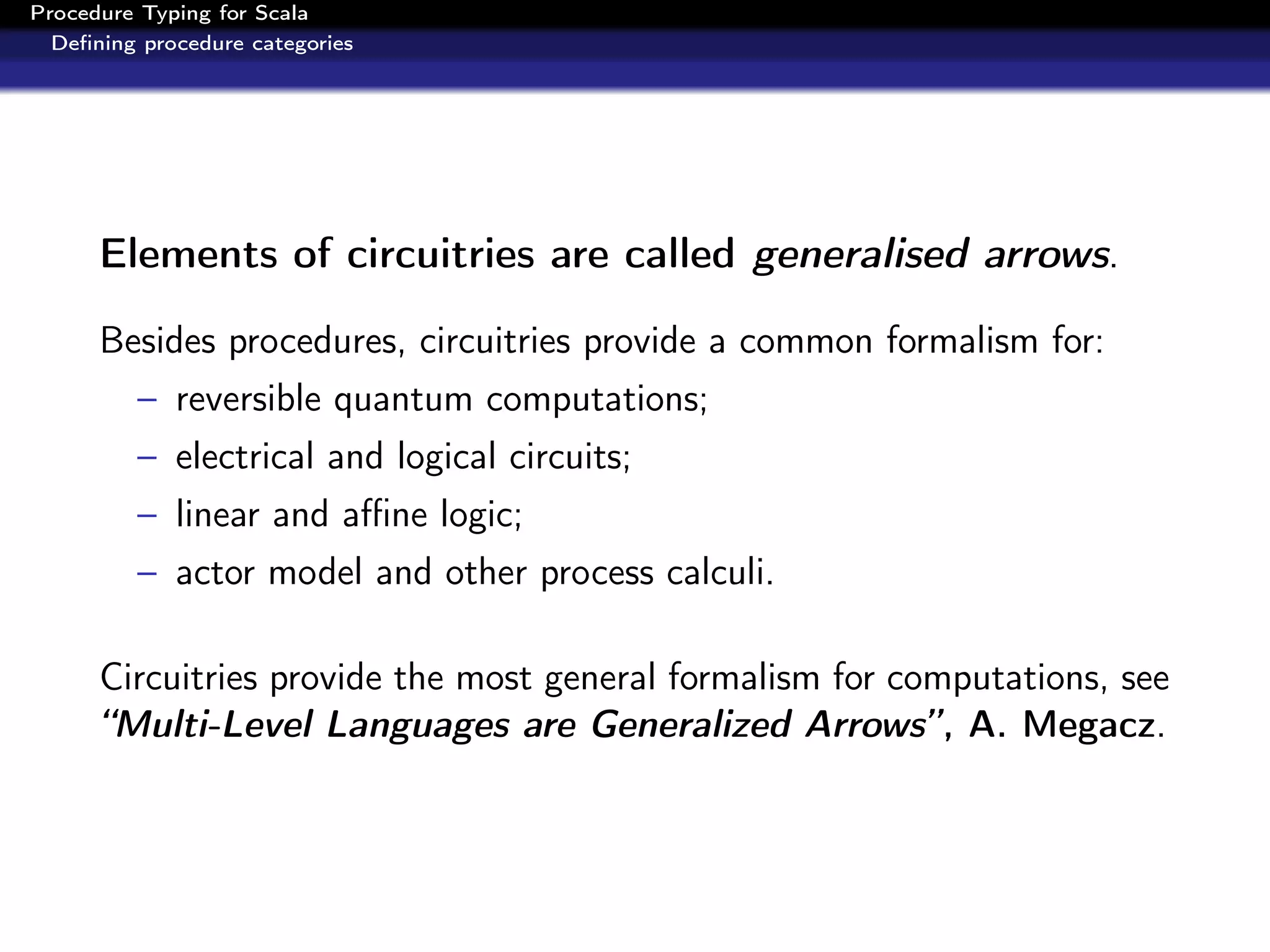
![Procedure Typing for Scala
Defining procedure categories
We are talking mostly about procedure typing, so we are going to
consider some special cases:
Arrow circuitries3 : circuitries generalising =>[Pure] .
Executable categories: categories generalising to =>[Proc] .
Procedure categories: executable cartesian4 procedure circuitries.
3
AKA plain old “arrows” in Haskell and scalaz.
4
i.e. having cartesian product types.](https://image.slidesharecdn.com/scala-circuitries-120408102919-phpapp02/75/Procedure-Typing-for-Scala-26-2048.jpg)
![Procedure Typing for Scala
Defining procedure categories
trait ArrowCircuitry[F[_,_]] extends Circuitry[F] {
def reify[A, B](f: A =>[Pure] B): A => B
... // With reify we get id and passl for free
}
trait Executable extends Category[_] {
def eval[A, B](f: A => B): A =>[Proc] B
// eval defines the execution strategy
}
trait ProcCategory[F[_,_]] extends ArrowCircuitry[F] with
Executable with Cartesian {
... // Some additional goodies
}](https://image.slidesharecdn.com/scala-circuitries-120408102919-phpapp02/75/Procedure-Typing-for-Scala-27-2048.jpg)
![Procedure Typing for Scala
Defining procedure categories
It’s time to give a full definition of =>[Logged] :
type Logged[A, B] = (A =>[Pure] (B, String))
object LoggedCircuitryImpl extends ProcCategory[Logged] {
def reify[A, B](f: A =>[Pure] B) = {x: A => (f(x), "")}
def compose[A, B, C](f: B => C, g: A => B) = {x: A =>
val (result1, logOutput1) = g(x)
val (result2, logOutput2) = f(result1)
(result2, logOutput1 + logOutput2)
}
def passr[A, B, C](f: A => B): = {x : (A, C) =>
val (result, log) = f(x._1)
((result, x._2), log)
}
def eval[A, B](p: A => B) = {x: A =>
val (result, log) = p(x)
println(log); result
}
}](https://image.slidesharecdn.com/scala-circuitries-120408102919-phpapp02/75/Procedure-Typing-for-Scala-28-2048.jpg)
![Procedure Typing for Scala
Defining procedure categories
It’s time to give a full definition of =>[Logged] :
type Logged[A, B] = (A =>[Pure] (B, String))
object LoggedCircuitryImpl extends ProcCategory[Logged] {
def reify[A, B](f: A =>[Pure] B) = {x: A => (f(x), "")}
def compose[A, B, C](f: B => C, g: A => B) = {x: A =>
val (result1, logOutput1) = g(x)
val (result2, logOutput2) = f(result1)
(result2, logOutput1 + logOutput2)
}
def passr[A, B, C](f: A => B): = {x : (A, C) =>
val (result, log) = f(x._1)
((result, x._2), log)
}
def eval[A, B](p: A => B) = {x: A =>
val (result, log) = p(x)
println(log); result
}
}
Wasn’t that easy?](https://image.slidesharecdn.com/scala-circuitries-120408102919-phpapp02/75/Procedure-Typing-for-Scala-29-2048.jpg)
![Procedure Typing for Scala
Defining procedure categories
Additionally we need a companion object for Logged[_,_] type.
That’s where circuitry-specific primitives should be defined.
object Logged {
val log: Logged[Unit, Unit] = {s: String => ((),s)}
}](https://image.slidesharecdn.com/scala-circuitries-120408102919-phpapp02/75/Procedure-Typing-for-Scala-30-2048.jpg)
![Procedure Typing for Scala
Defining procedure categories
Other circuitry-specific primitives include:
– throw and catch for =>[Throws[E]]
– shift and reset for =>[Cont]
– match/case and if/else for =>[WithChoice]
– while and recursion for =>[WithLoops]
– etc.
Often they have to be implemented with Scala macros (available in
a next major Scala release near you).](https://image.slidesharecdn.com/scala-circuitries-120408102919-phpapp02/75/Procedure-Typing-for-Scala-31-2048.jpg)
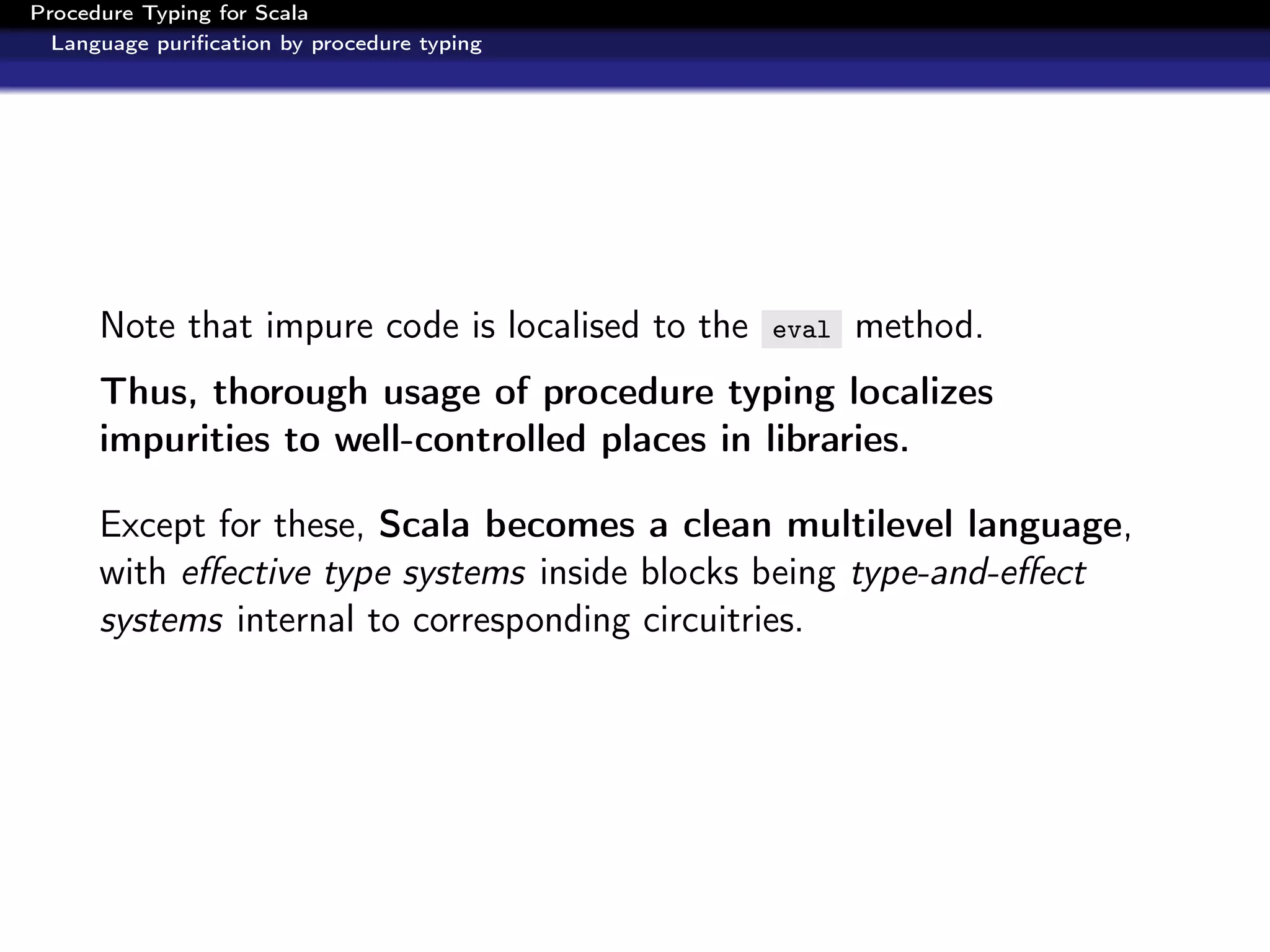
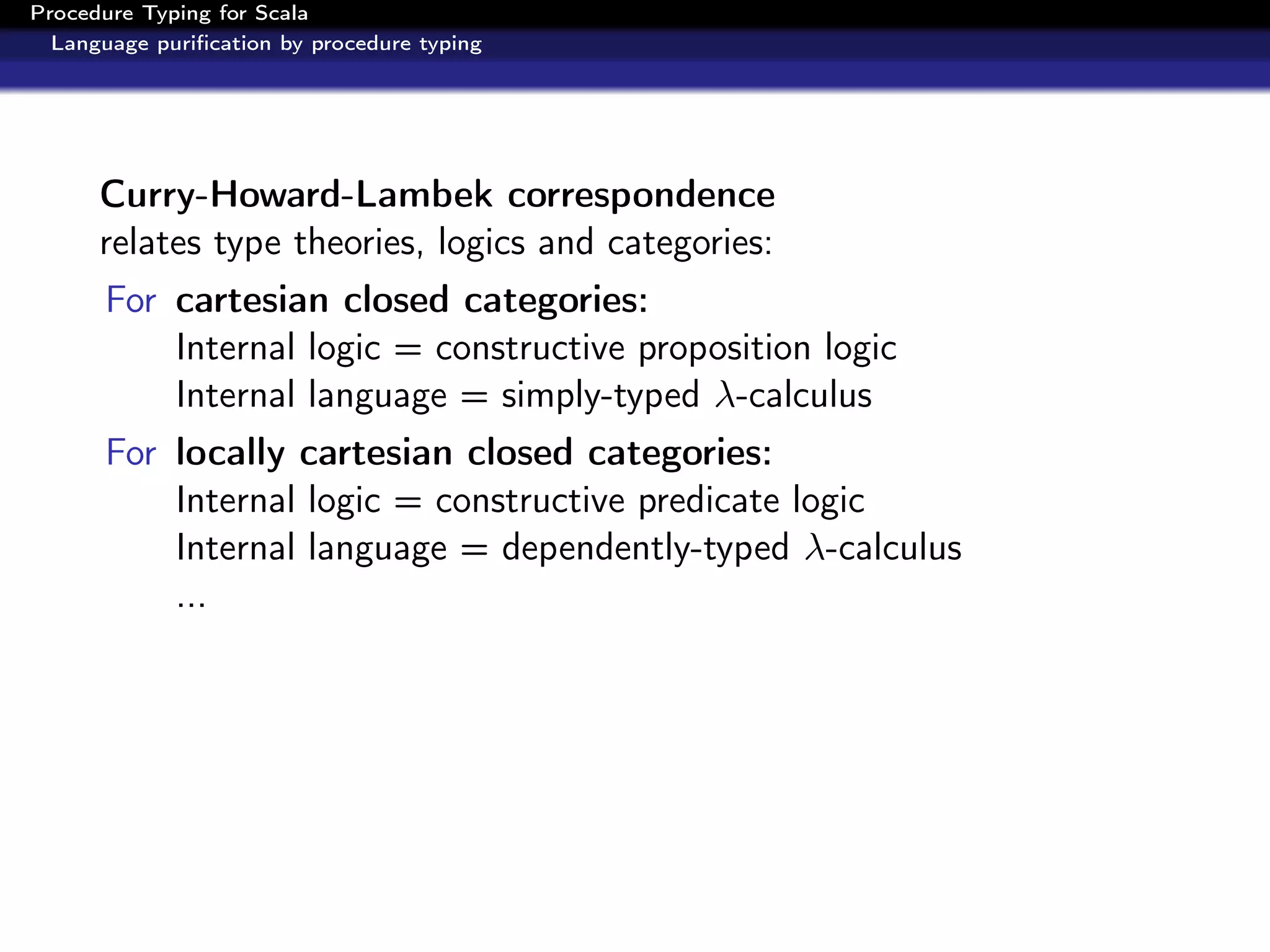
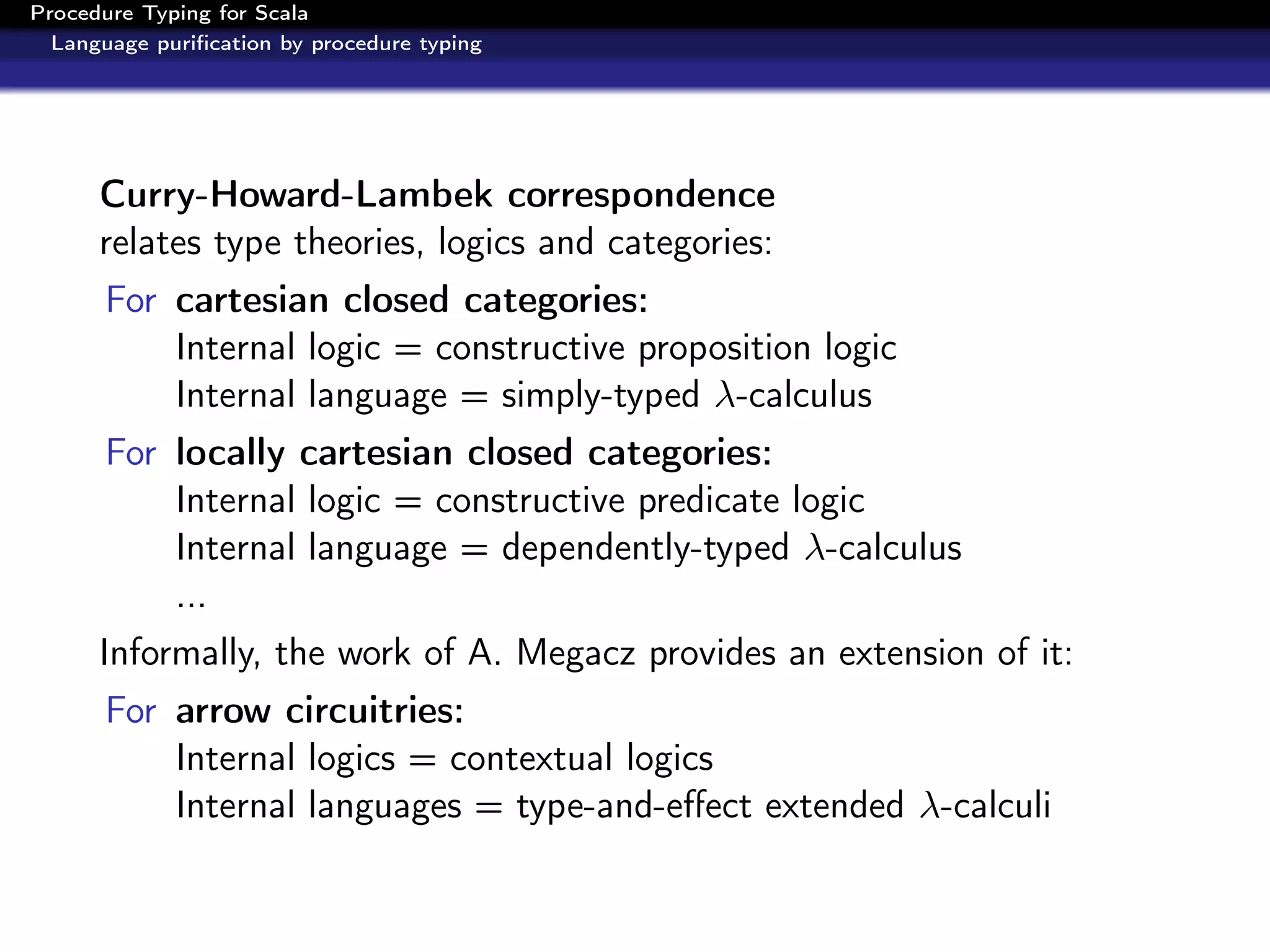
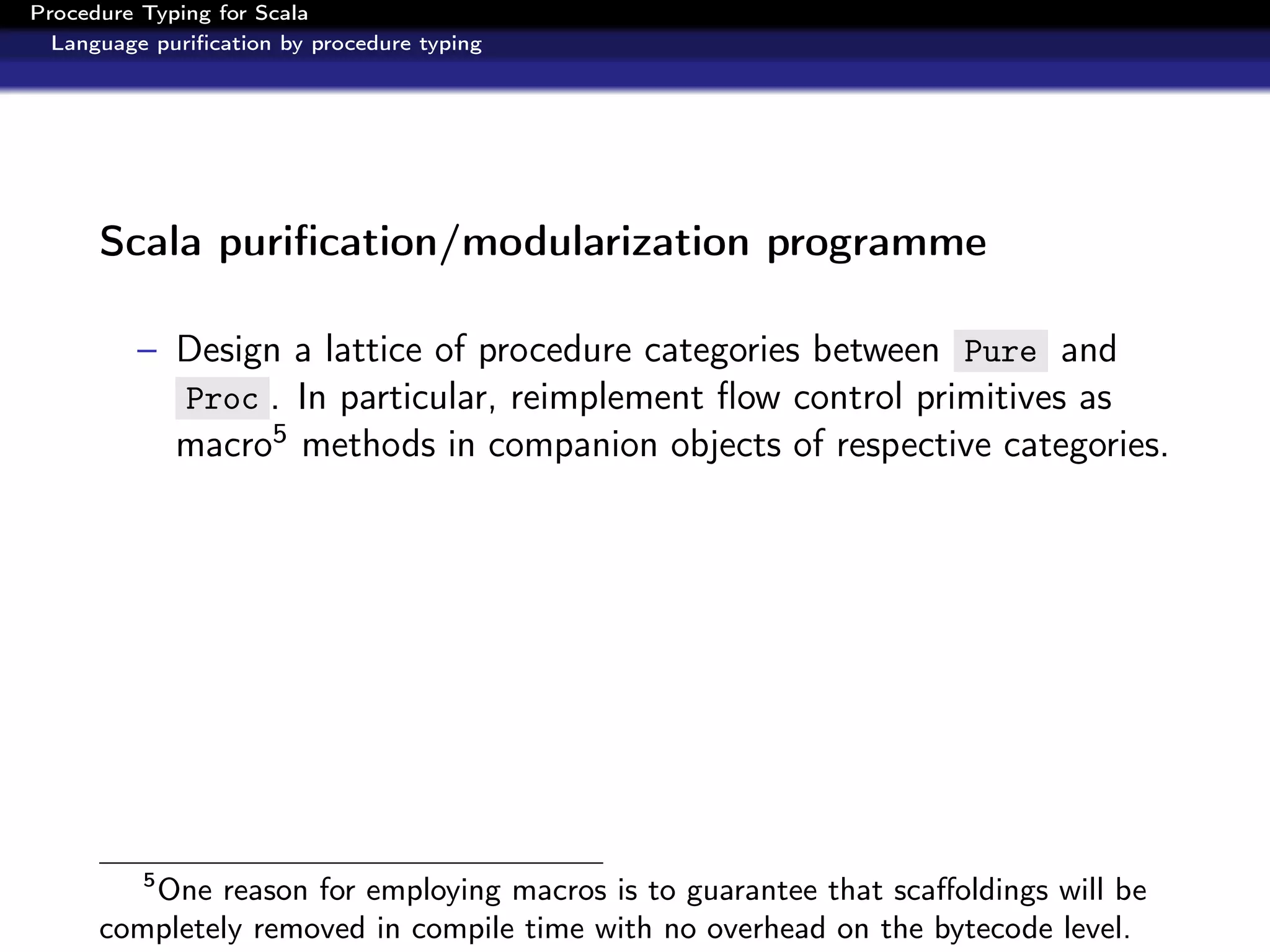
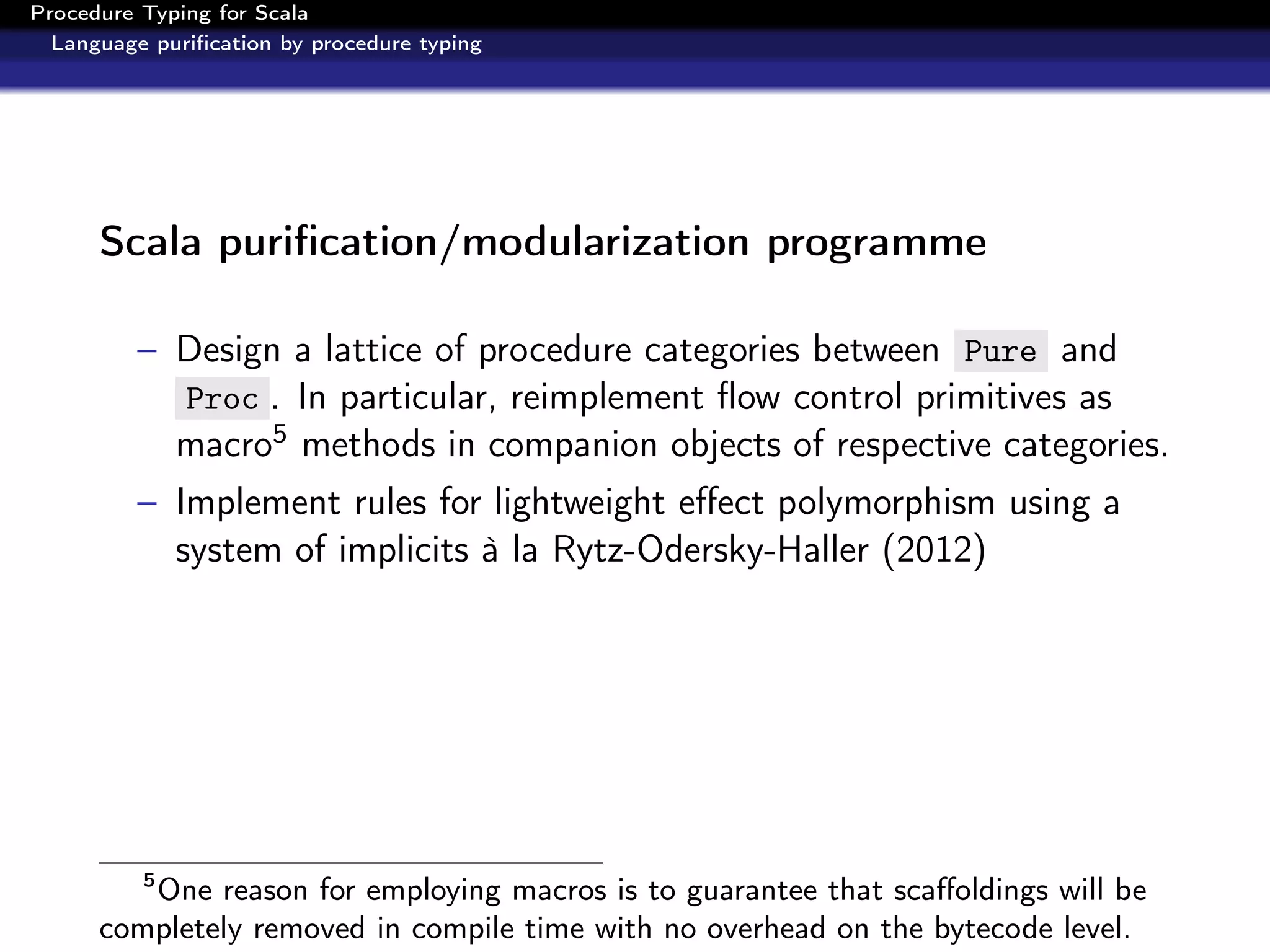
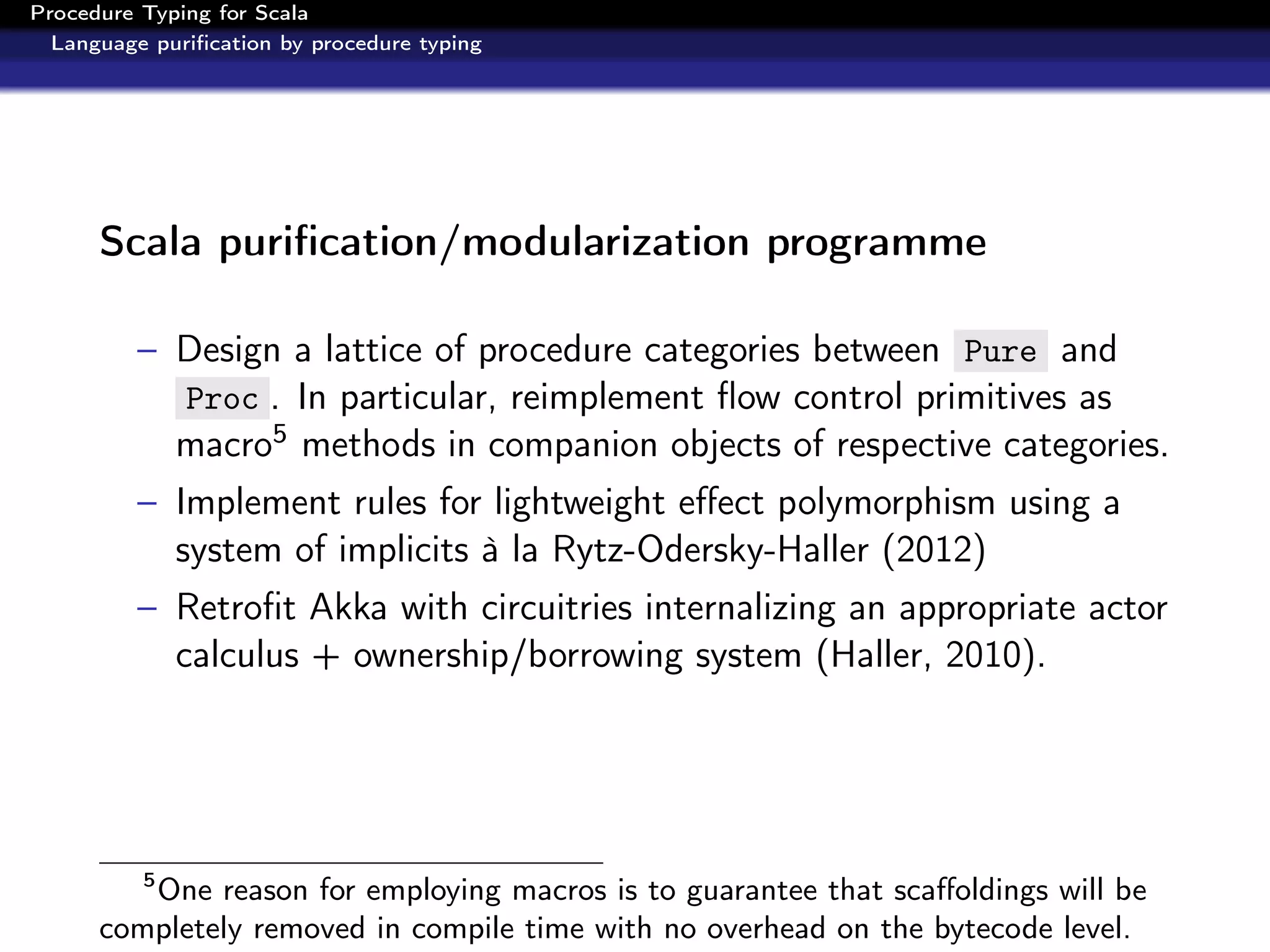
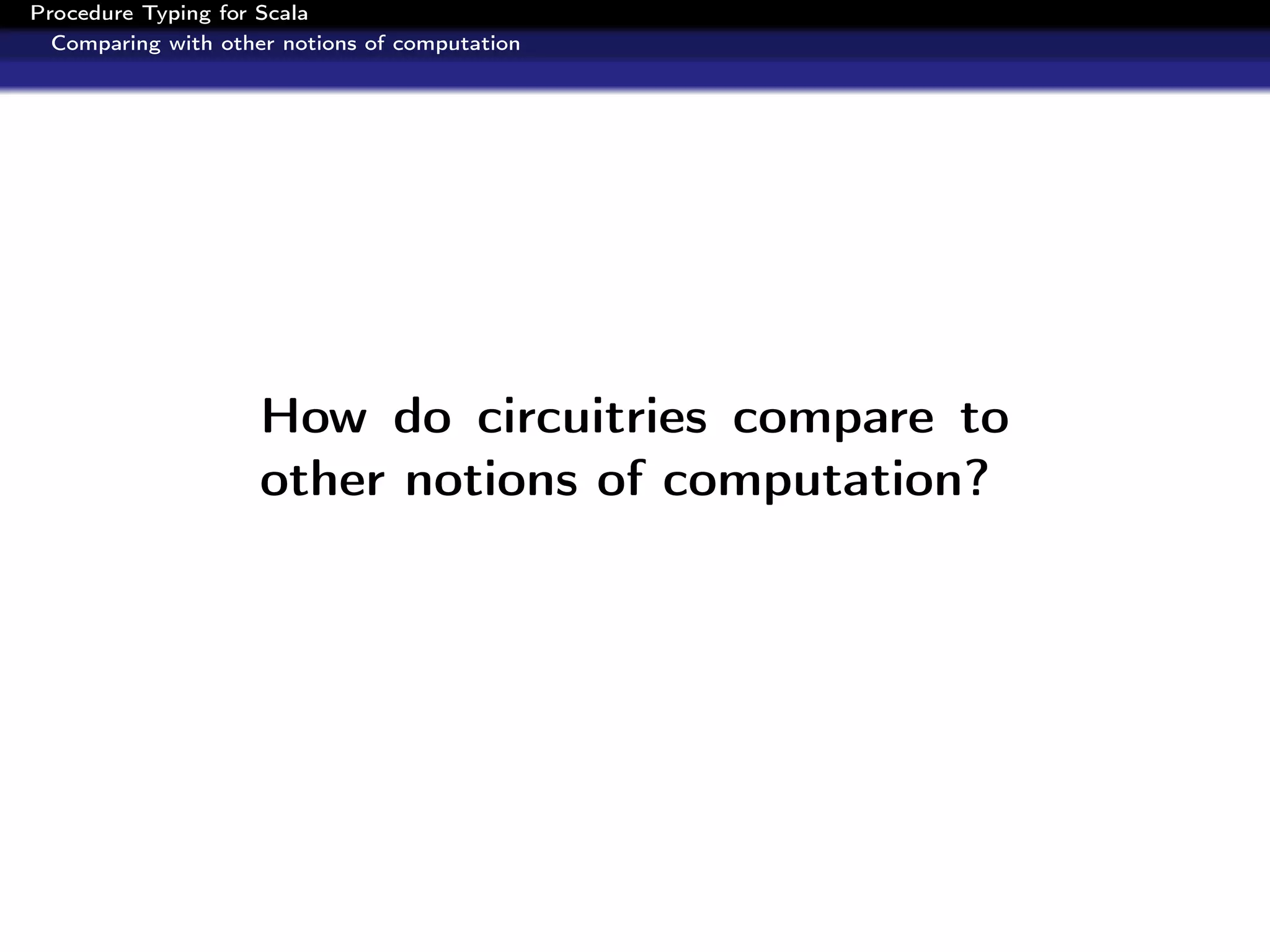
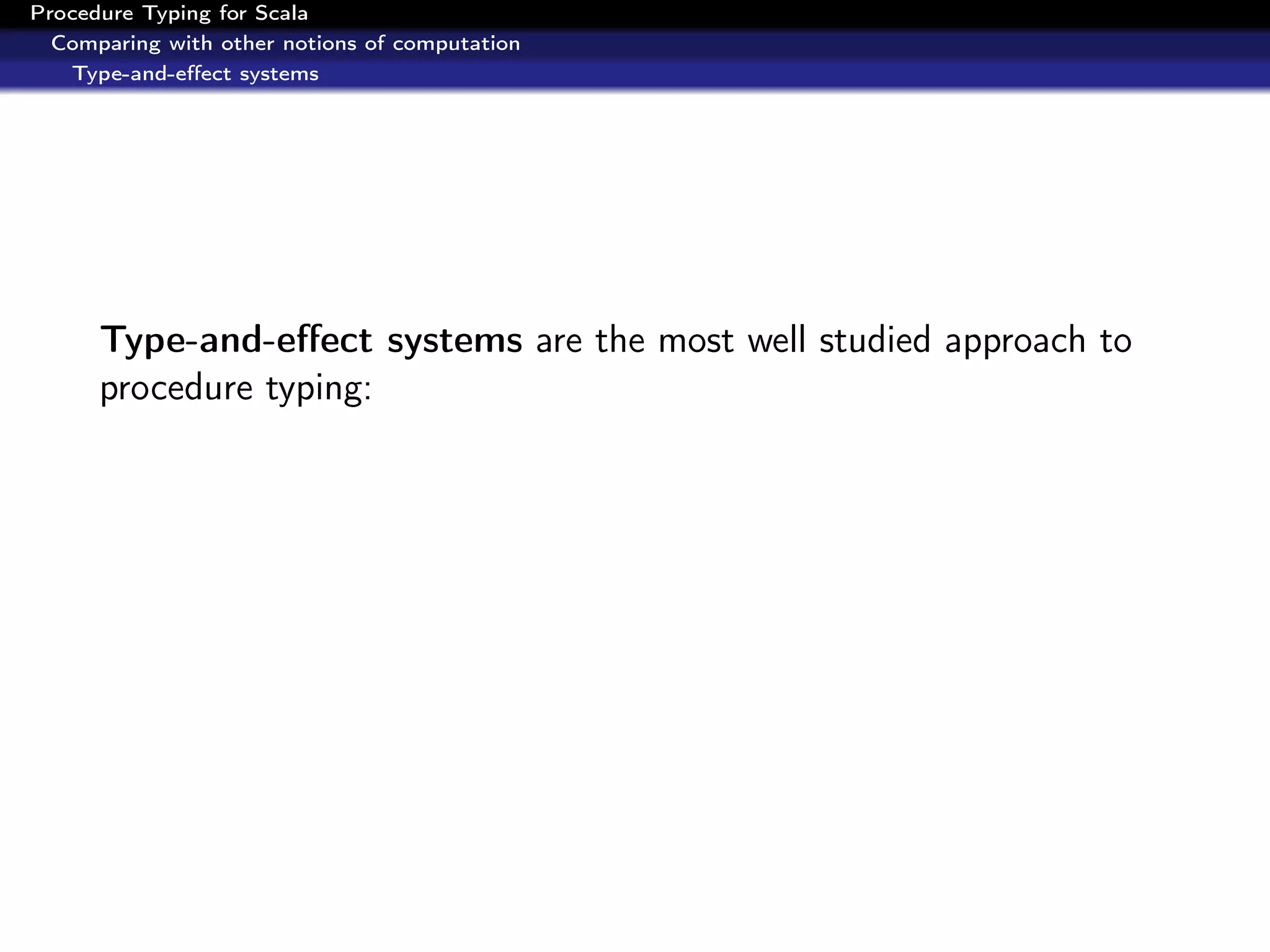
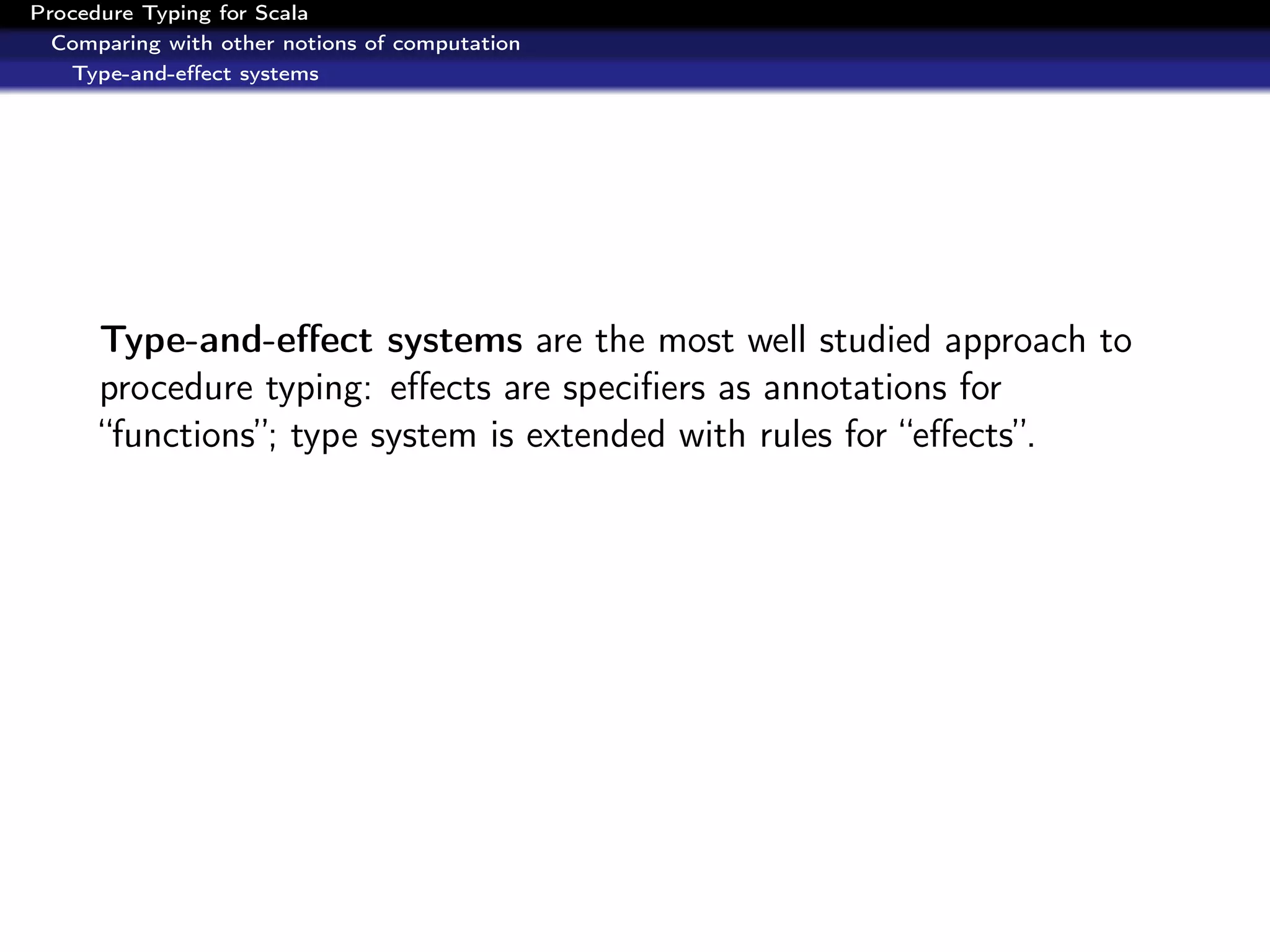
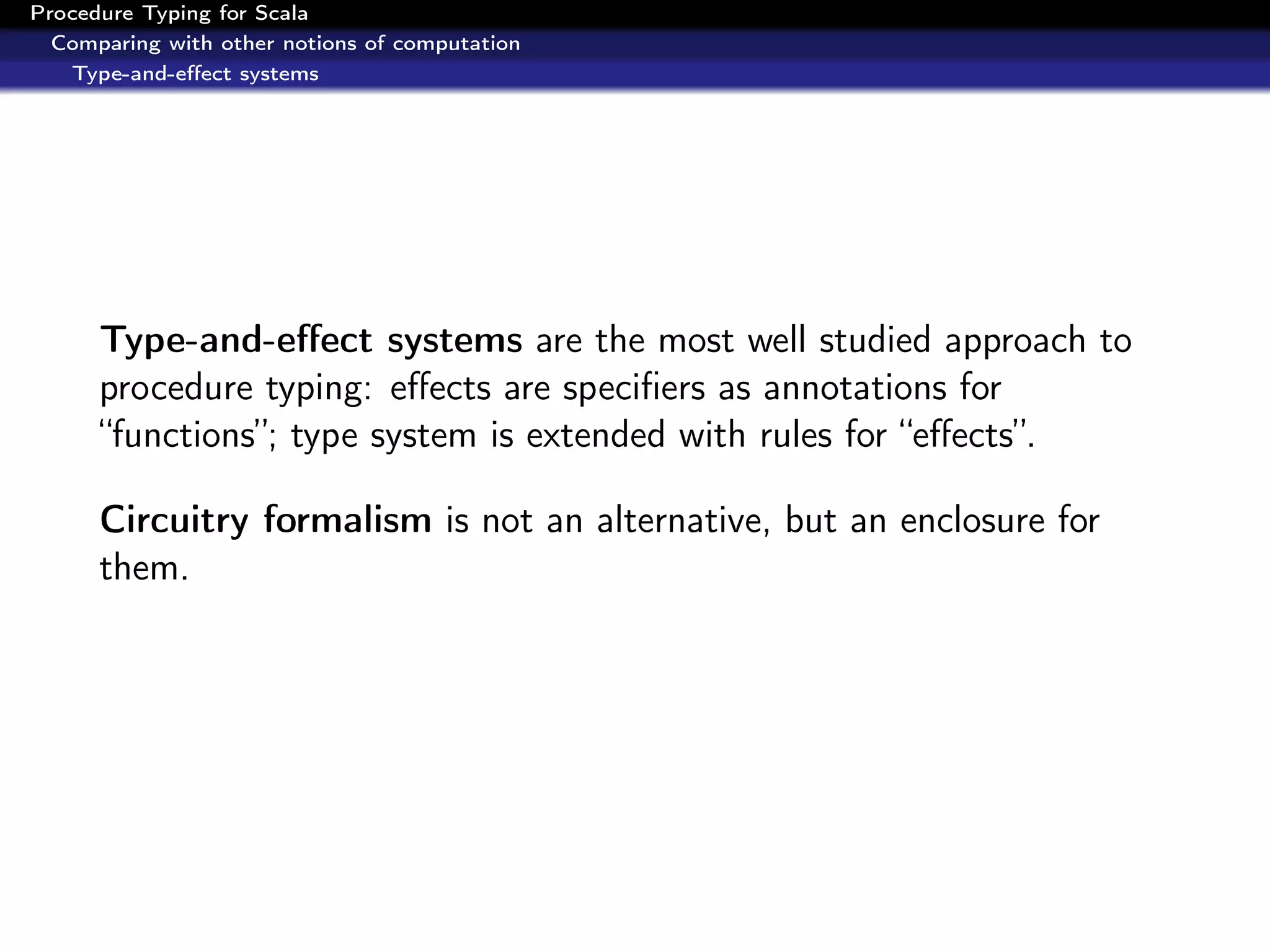
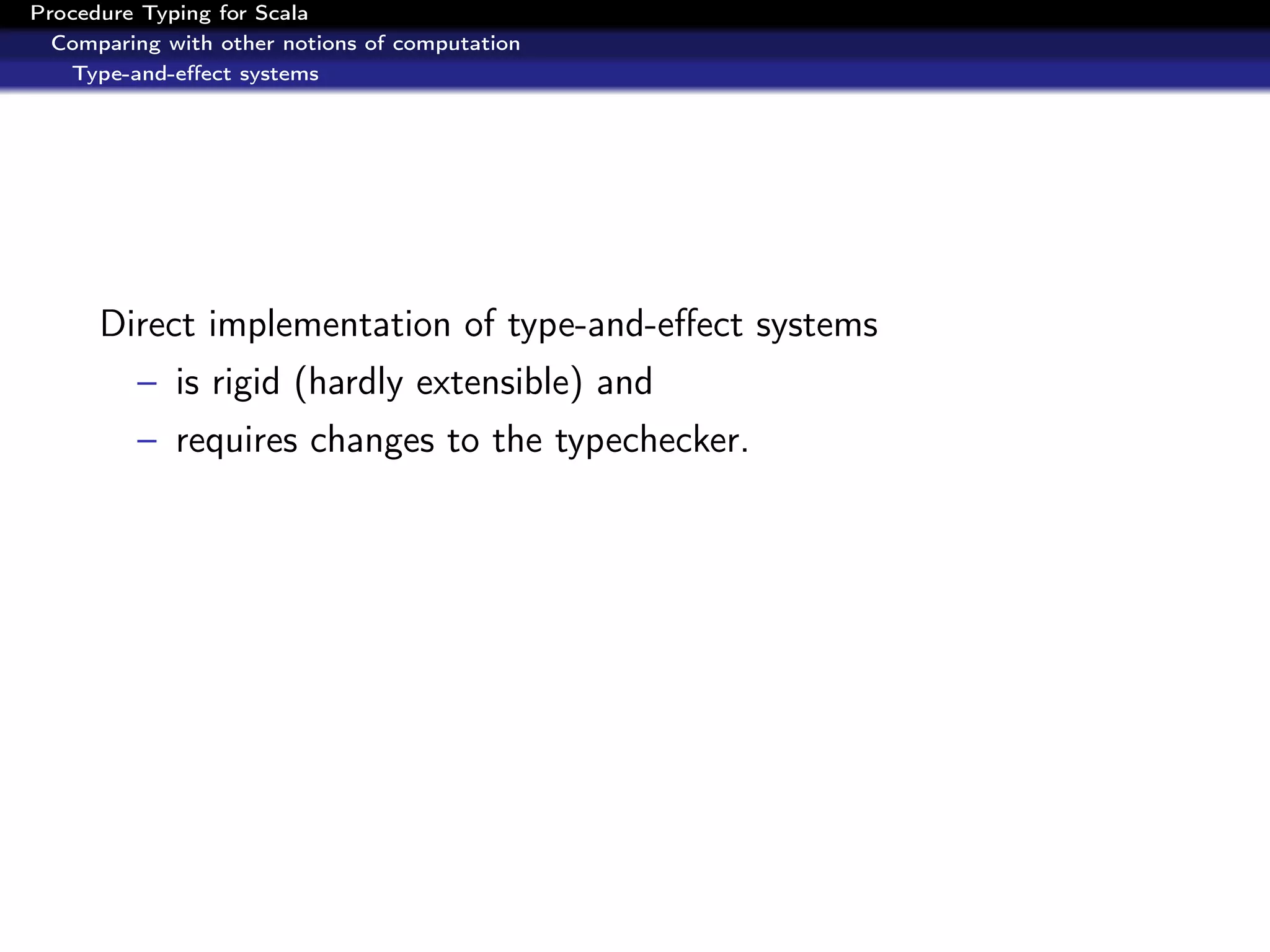
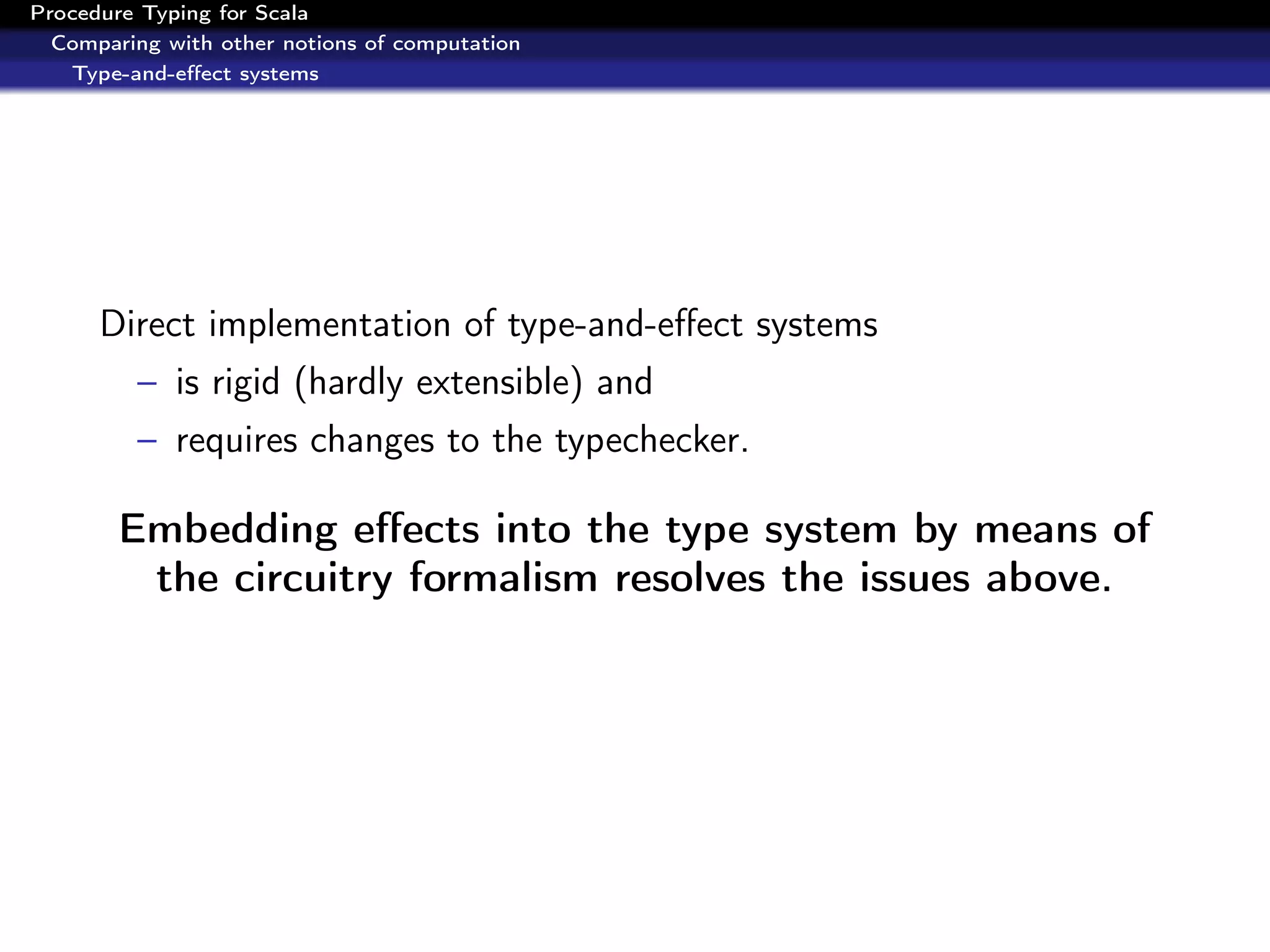
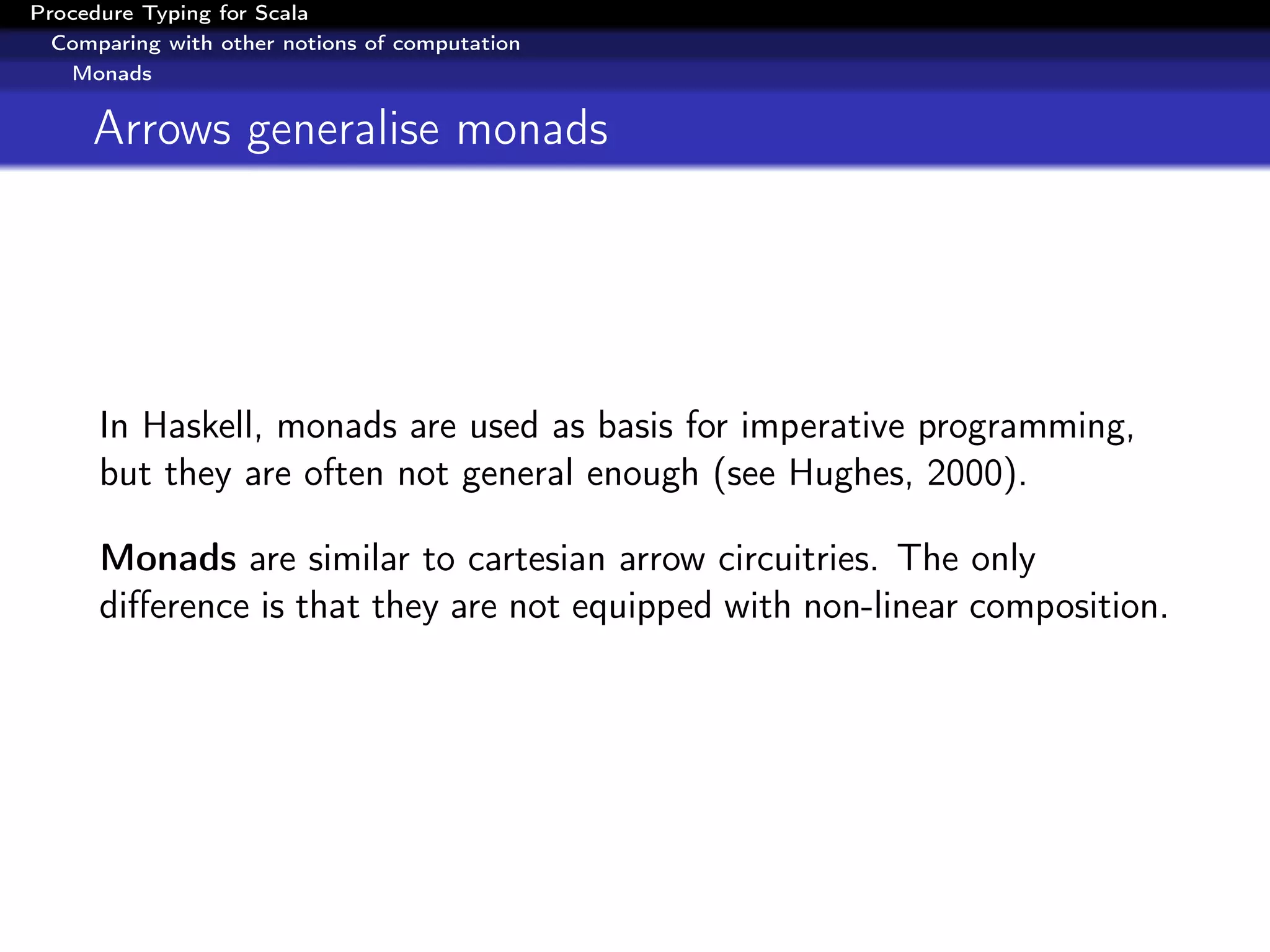
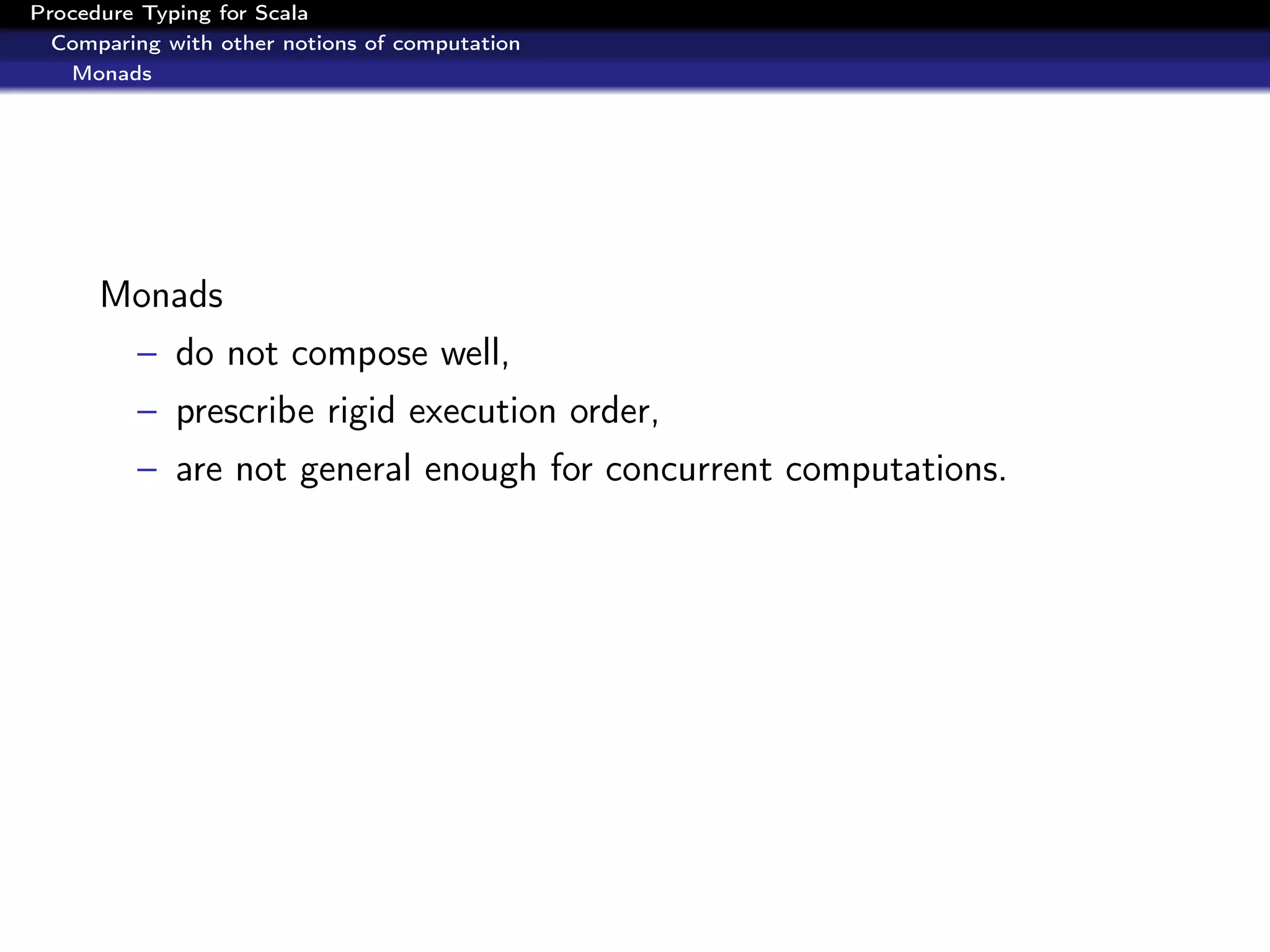
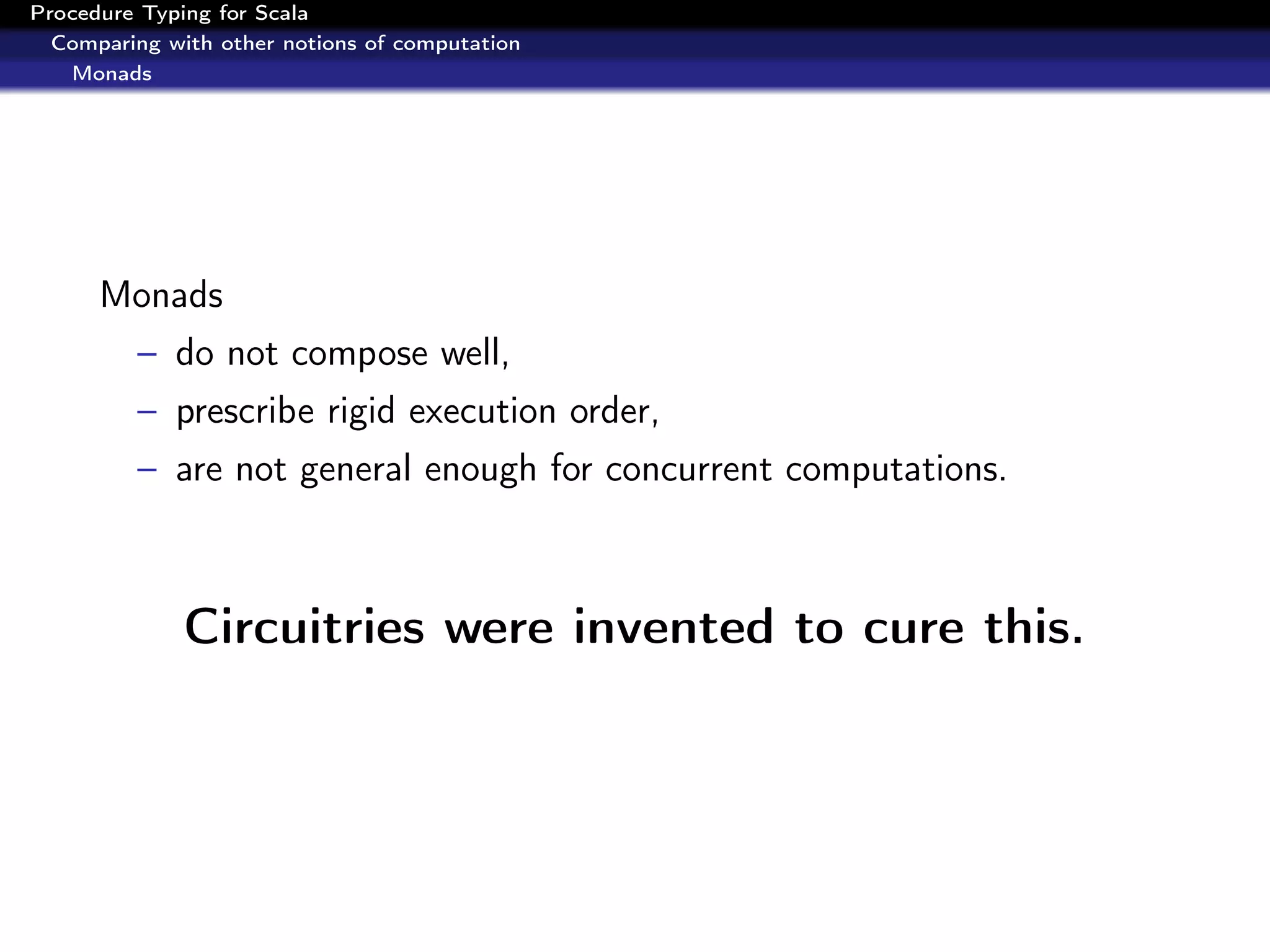
![Procedure Typing for Scala
Comparing with other notions of computation
Applicatives
Applicatives are a special case of arrows...
If procedures of type =>[A] never depend on effects of other
procedures of the same type, A is called essentially commutative.
Example
=>[Reads(config), Writes(log), Throws[NonBlockingException]]
Essentially commutative arrows arise from applicative functors.
They are flexible and easy to handle: you don’t have to propagate
effects, just accumulate them behind the scenes.](https://image.slidesharecdn.com/scala-circuitries-120408102919-phpapp02/75/Procedure-Typing-for-Scala-47-2048.jpg)
![Procedure Typing for Scala
Comparing with other notions of computation
Applicatives
...but not a closed special case!
Composing applicatives may produce non-commutative circuitries
like =>[Reads(file), Writes(file)] .
Procedures of this type are no longer effect-independent: effect of
writes have to be passed to subsequent reads.
Besides these, there are also inherently non-commutative arrows
such as those arising from monads6 , comonads and Hoare triples7 .
6
e.g. Tx = transaction monad, Cont = continuation passing monad.
7
pre- and postconditioned arrows.](https://image.slidesharecdn.com/scala-circuitries-120408102919-phpapp02/75/Procedure-Typing-for-Scala-48-2048.jpg)
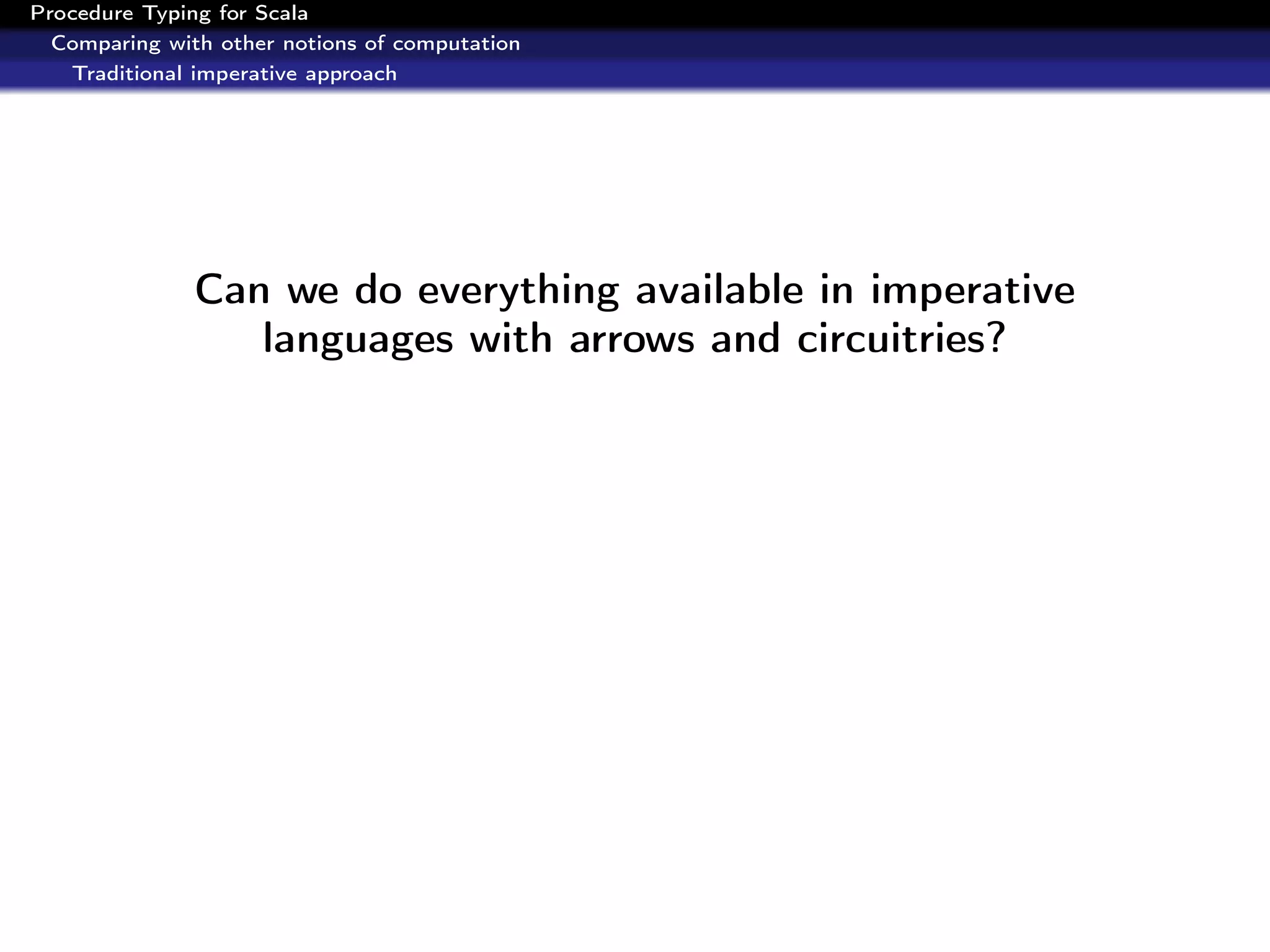
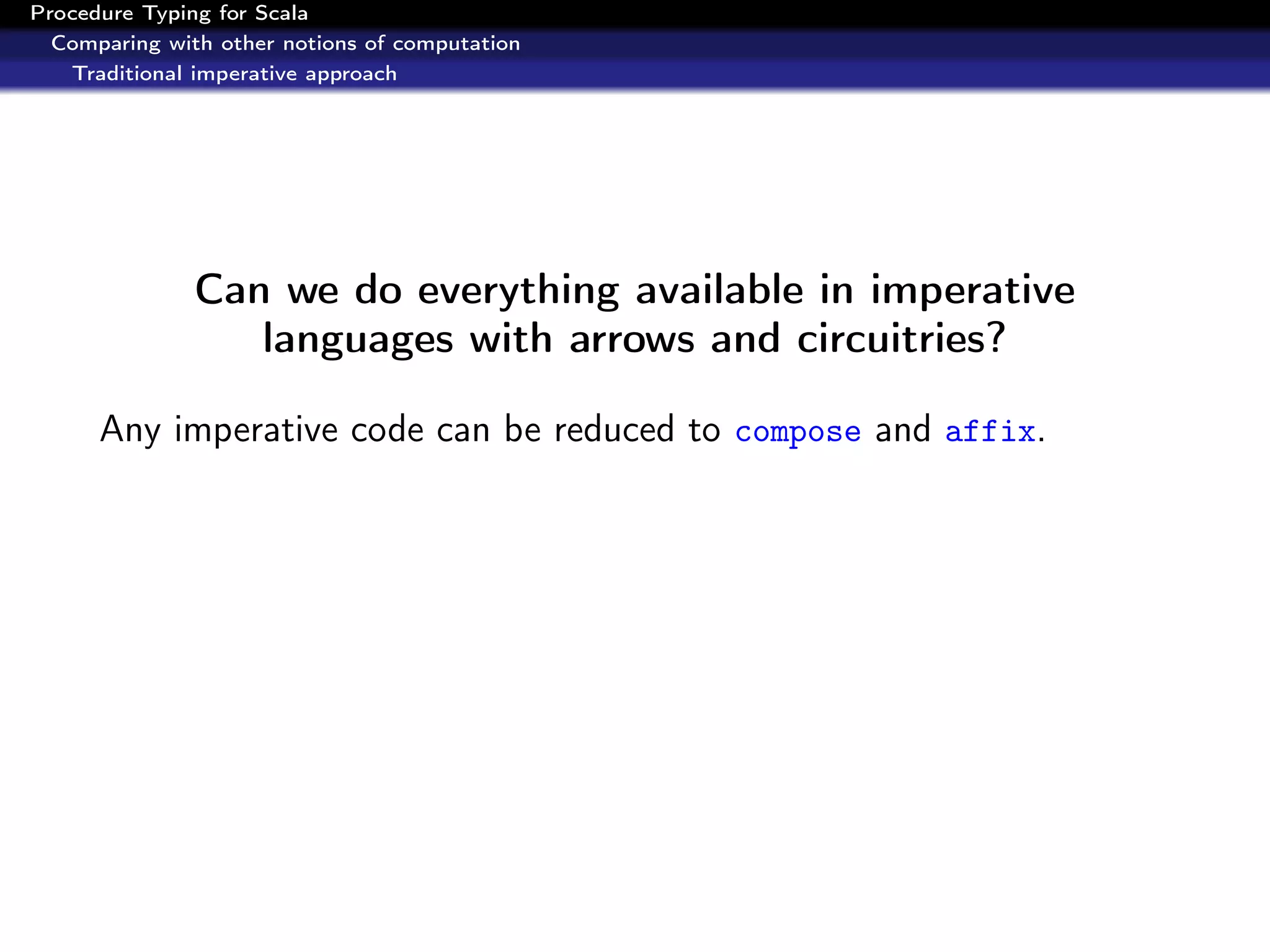
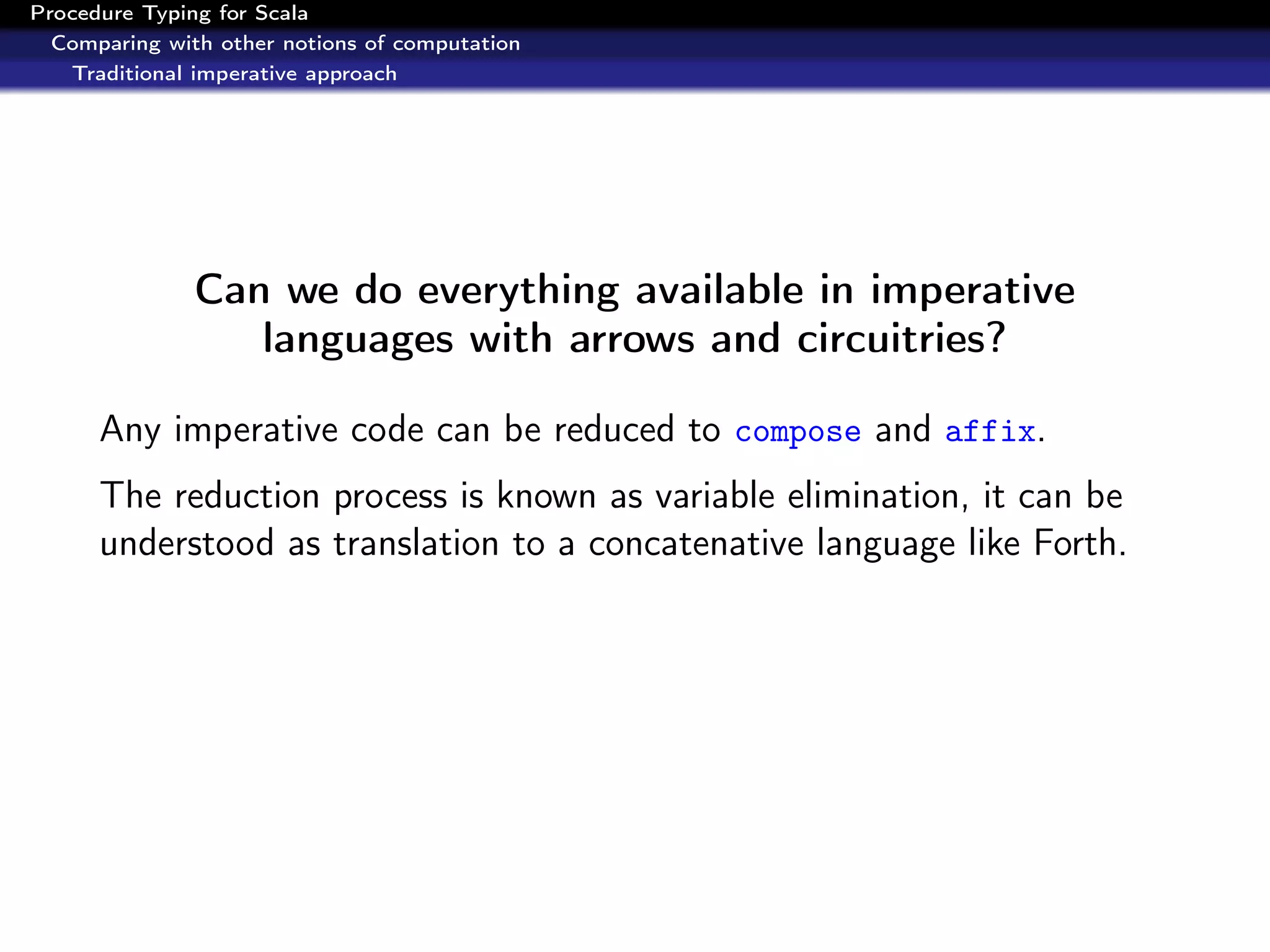
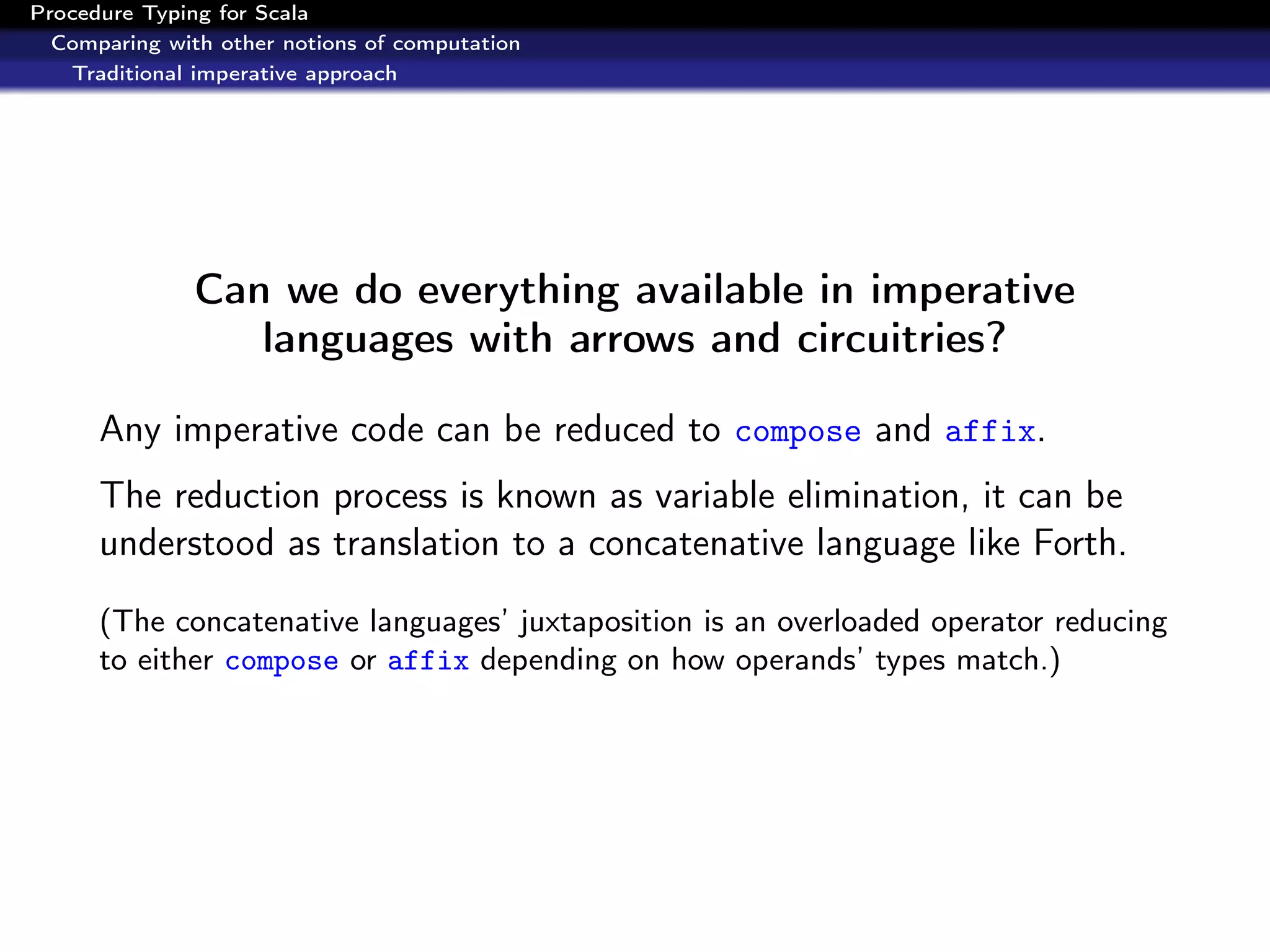
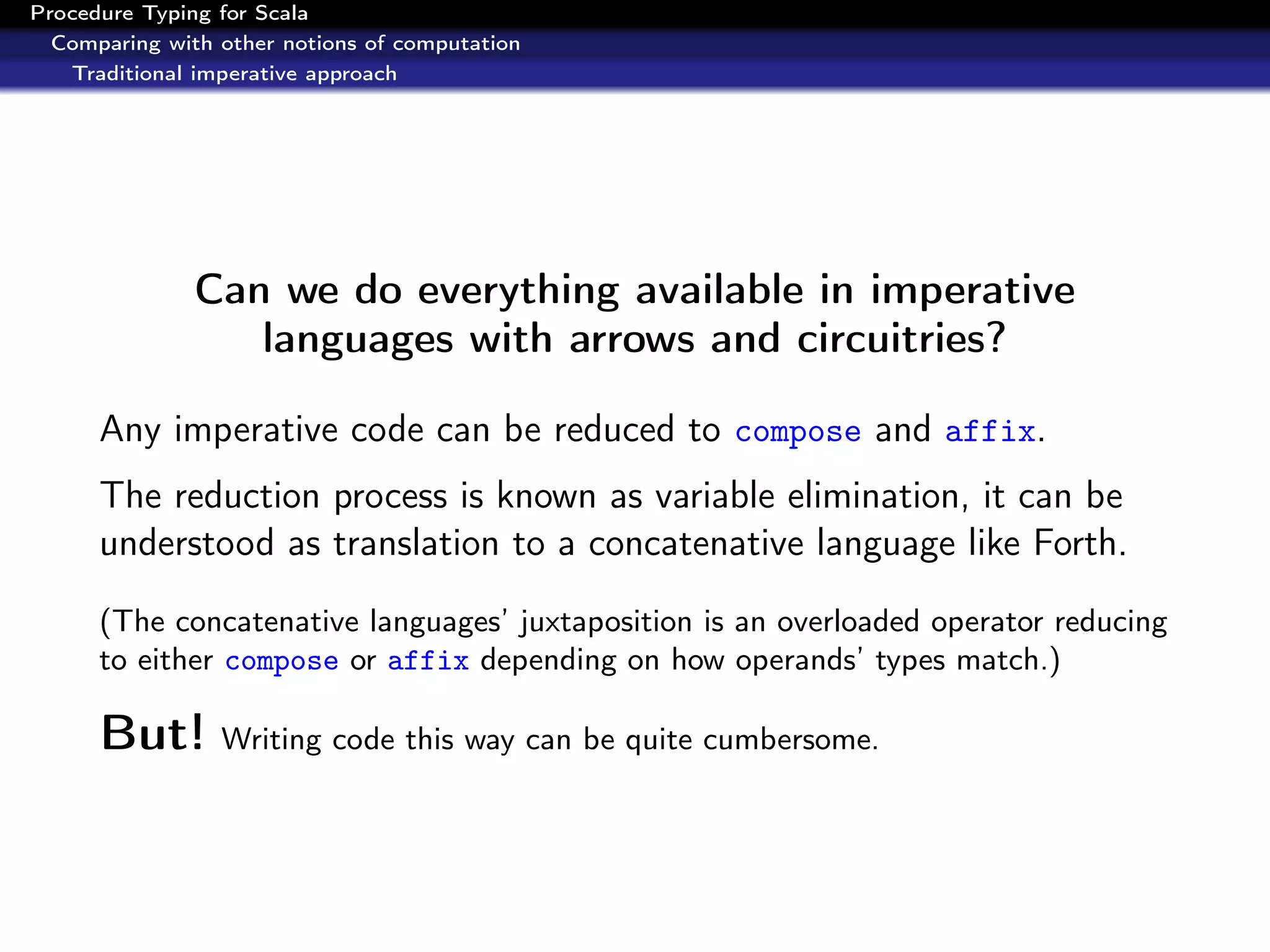
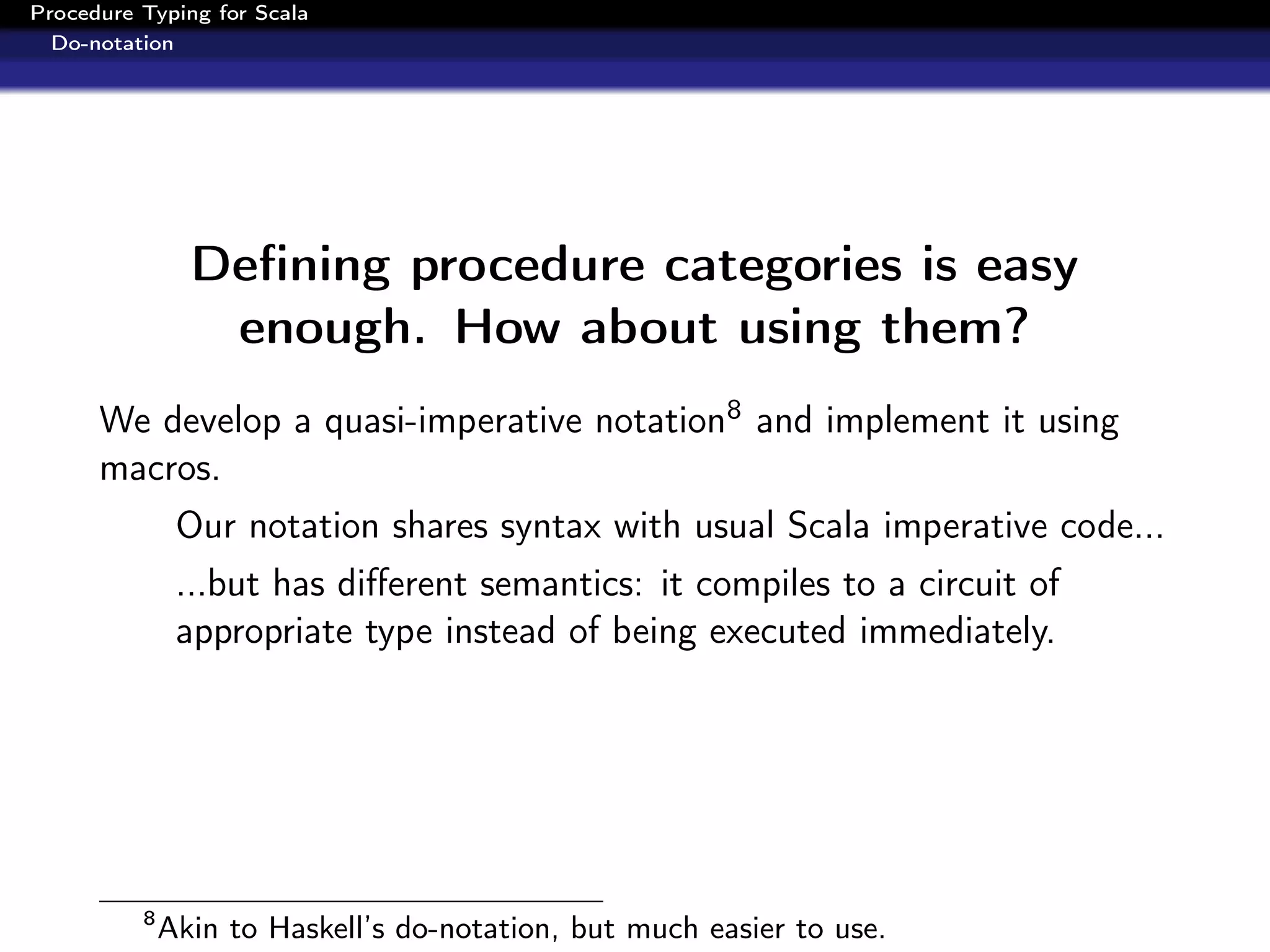
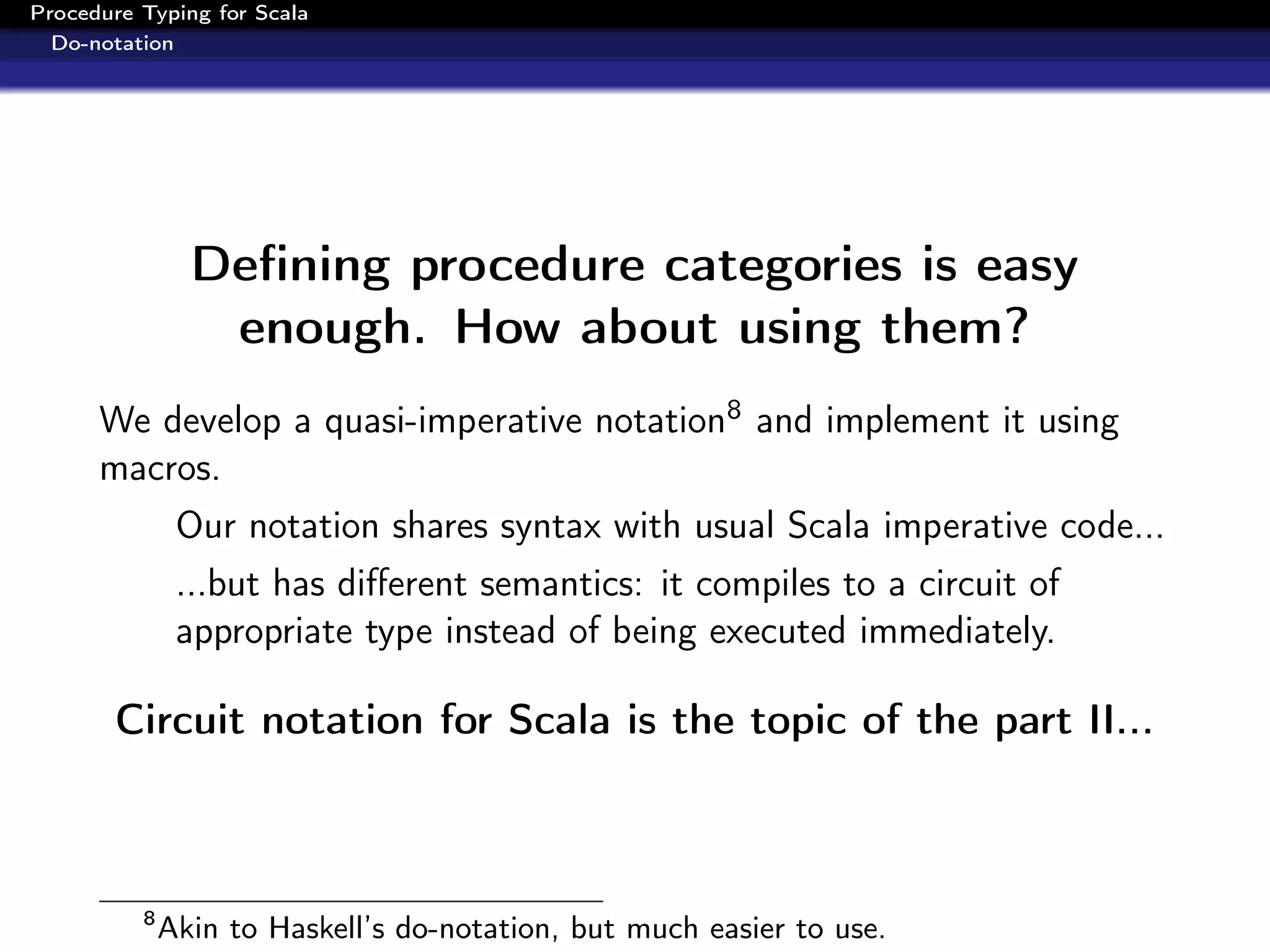
![Procedure Typing for Scala
Do-notation
Do-notation example
...but here’s a small example to keep your interest
Even pure functions have a side effect: they consume time.
=>[Future] is an example of a retrofitting procedure category9 .
=>[Future] {
val a = alpha(x)
val b = beta(x)
after (a | b) {
Log.info("First one is completed")
}
after (a & b) {
Log.info("Both completed")
}
gamma(a, b)
}
9
its reify is a macro, so any procedures can be retrofitted to be =>[Future].](https://image.slidesharecdn.com/scala-circuitries-120408102919-phpapp02/75/Procedure-Typing-for-Scala-56-2048.jpg)
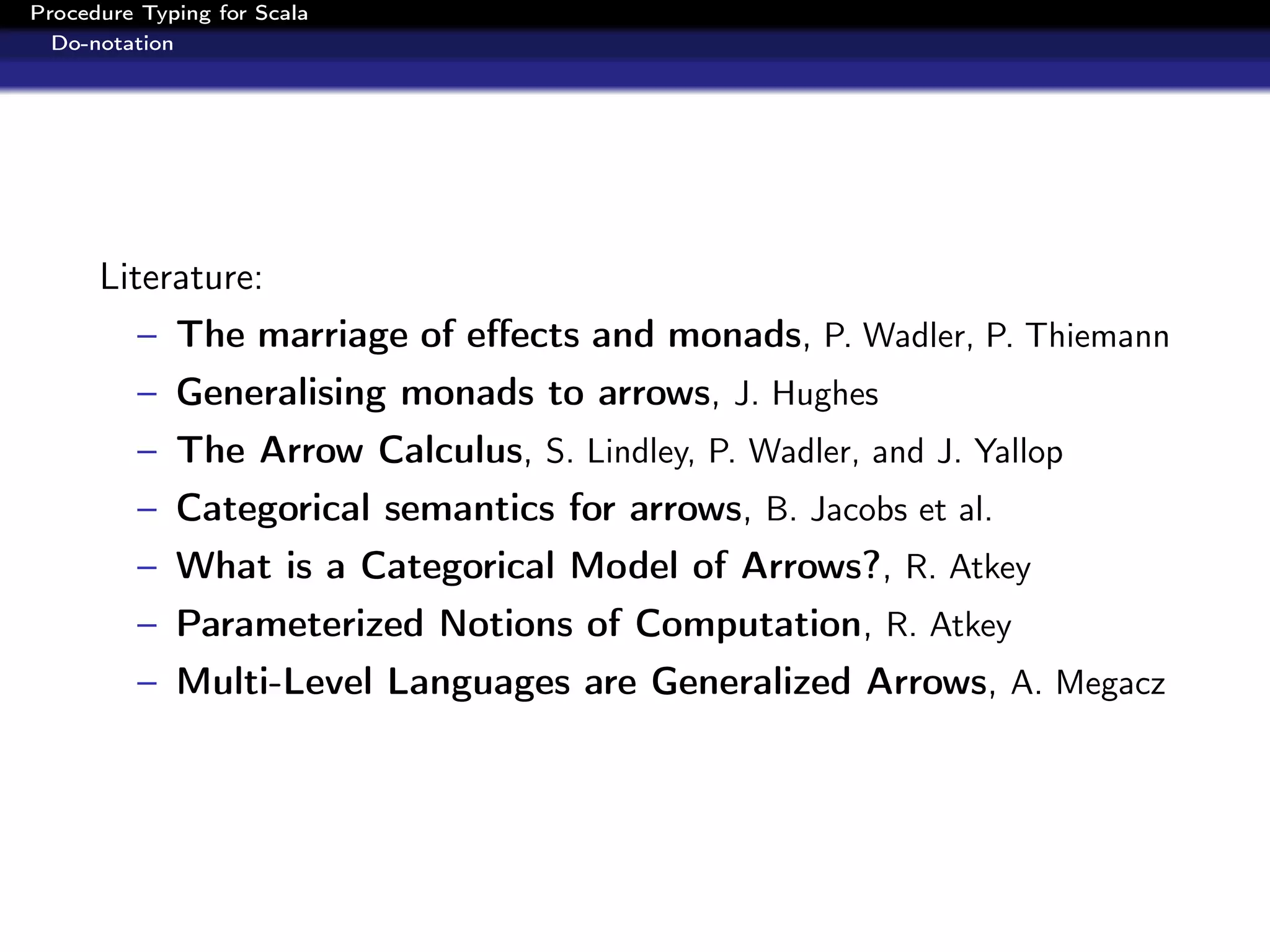
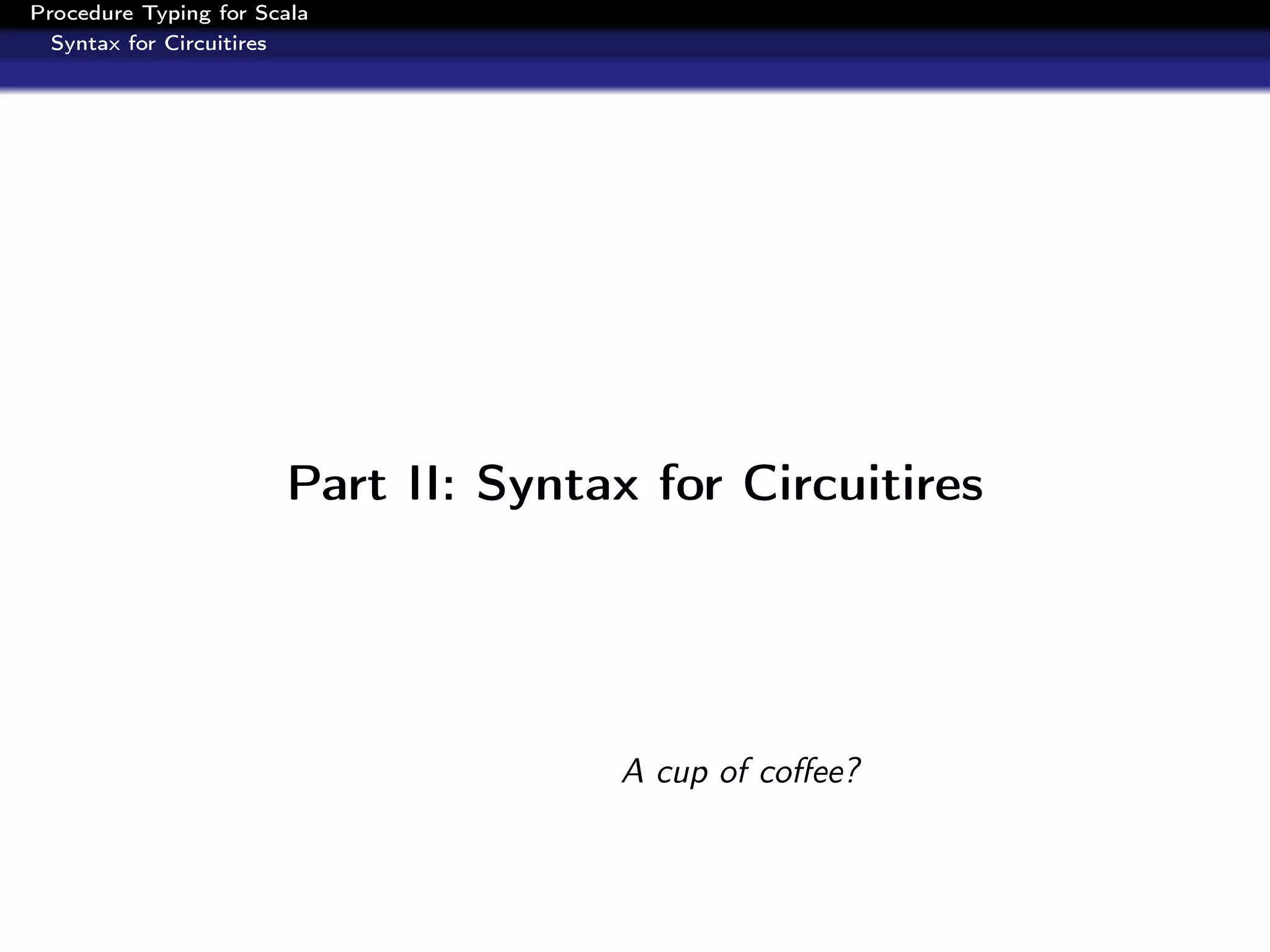
![Procedure Typing for Scala
Syntax for Circuitires
Implicit Unboxing
How do you use an arrow (say f: Logged[Int, String] ) in
present Scala code?
println(f(5)) seems to be the obvious way, but that’s
impossible, application is not defined for f.
To facilitate such natural notation, we need implicit unboxing.](https://image.slidesharecdn.com/scala-circuitries-120408102919-phpapp02/75/Procedure-Typing-for-Scala-59-2048.jpg)
![Procedure Typing for Scala
Syntax for Circuitires
Implicit Unboxing
Preliminaries
A wrapping is a type F[_] equipped with eval[T](v: F[T]): T
and reify[T](expr: => T): F[T] (reify often being a macro) so
that
eval(reify(x)) ≡ x and
reify(eval(x)) ≡ x for all x of the correct type.](https://image.slidesharecdn.com/scala-circuitries-120408102919-phpapp02/75/Procedure-Typing-for-Scala-60-2048.jpg)
![Procedure Typing for Scala
Syntax for Circuitires
Implicit Unboxing
Preliminaries
A wrapping is a type F[_] equipped with eval[T](v: F[T]): T
and reify[T](expr: => T): F[T] (reify often being a macro) so
that
eval(reify(x)) ≡ x and
reify(eval(x)) ≡ x for all x of the correct type.
A prototypical example where reify is a macro is Expr[T]. Example
with no macros involved is Future[T] (with await as eval).](https://image.slidesharecdn.com/scala-circuitries-120408102919-phpapp02/75/Procedure-Typing-for-Scala-61-2048.jpg)
![Procedure Typing for Scala
Syntax for Circuitires
Implicit Unboxing
Preliminaries
Implicit unboxing is this: whenever a value of the wrapping type
F[T] is found where a value of type T is accepted, its eval is called
implicitly.
In homoiconic languages (including Scala), all expressions can be
considered initially having the type Expr[T] and being unboxed into
T by an implicit unboxing rule Expr[T] => T .](https://image.slidesharecdn.com/scala-circuitries-120408102919-phpapp02/75/Procedure-Typing-for-Scala-62-2048.jpg)
![Procedure Typing for Scala
Syntax for Circuitires
Implicit Unboxing
Syntax proposal
Let’s introduce an instruction implicit[F] enabling implicit
unboxing for F in its scope.
Implicit contexts can be implemented using macros:
– macro augments the relevant scope by F.reify as an implicit
conversion from F[T] to T;
– F.eval is applied to every occurrence of a symbol having or
returning type F[T] which is defined outside of its scope.](https://image.slidesharecdn.com/scala-circuitries-120408102919-phpapp02/75/Procedure-Typing-for-Scala-63-2048.jpg)
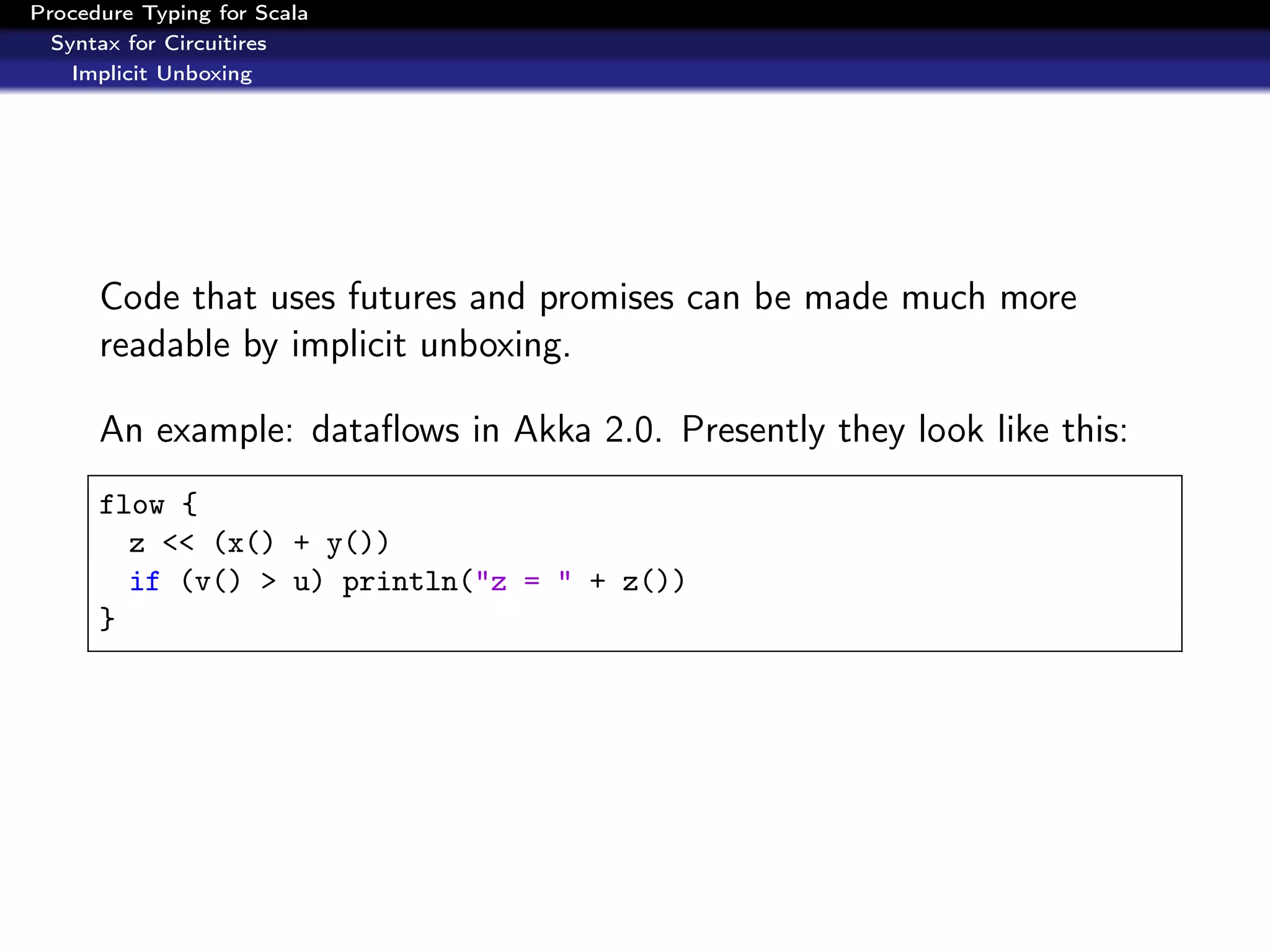
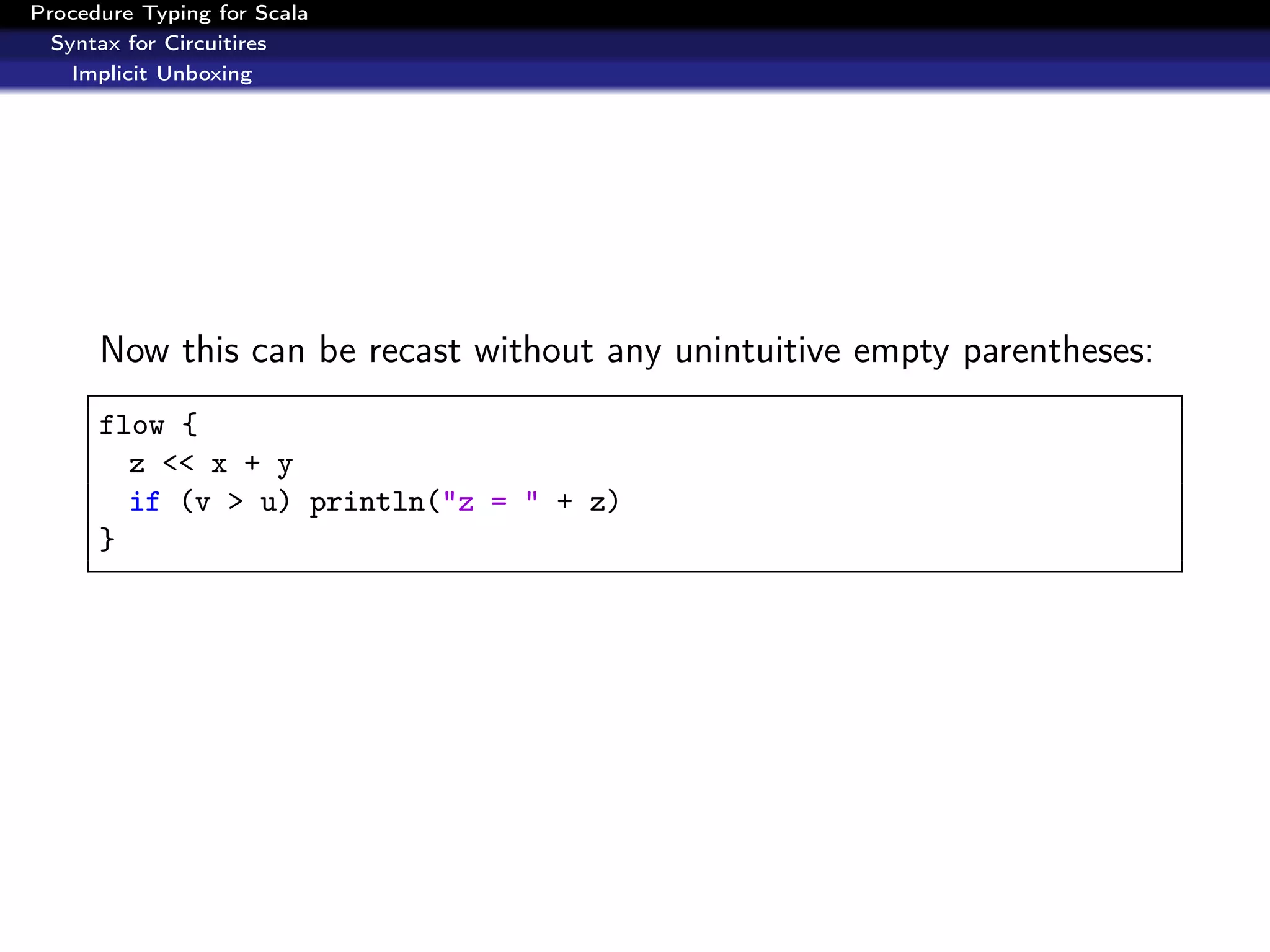
![Procedure Typing for Scala
Syntax for Circuitires
Implicit Unboxing
Back to our Logged example:
implicit[Logged]
def example(f: Int =>[Logged] String, n: Int): List[String] {
f(n).split(", ")
}
Which translates to:
def example(f: Int =>[Logged] String, n: Int): List[String] {
LoggedCircuitryImpl.eval(f)(n).split(", ")
}](https://image.slidesharecdn.com/scala-circuitries-120408102919-phpapp02/75/Procedure-Typing-for-Scala-66-2048.jpg)
![Procedure Typing for Scala
Syntax for Circuitires
Purifying Scala
Now, which procedure category should example() belong to?
As it evaluates =>[Logged], it should be =>[Logged] itself. This
allows its reinterpretation without any usage of eval:
def example(f: Int =>[Logged] String, n: Int): List[String] = {
import LoggedCircuitryImpl._
reify{n} andThen f andThen reify{_.split(", ")}
}
This is now a pure code generating a new circuit of the type
=>[Logged] based on the existing one (f) and some pure functions.](https://image.slidesharecdn.com/scala-circuitries-120408102919-phpapp02/75/Procedure-Typing-for-Scala-67-2048.jpg)
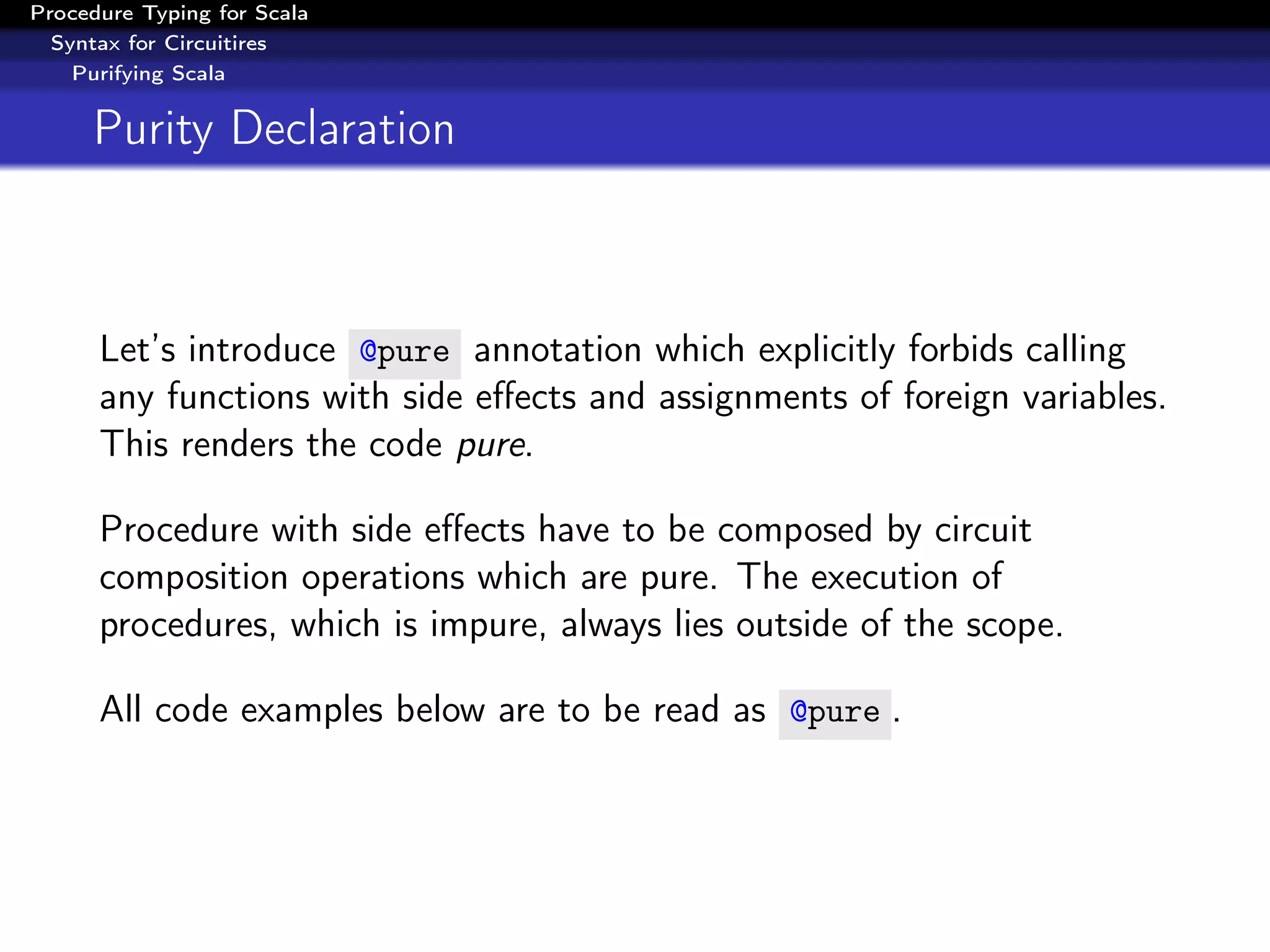
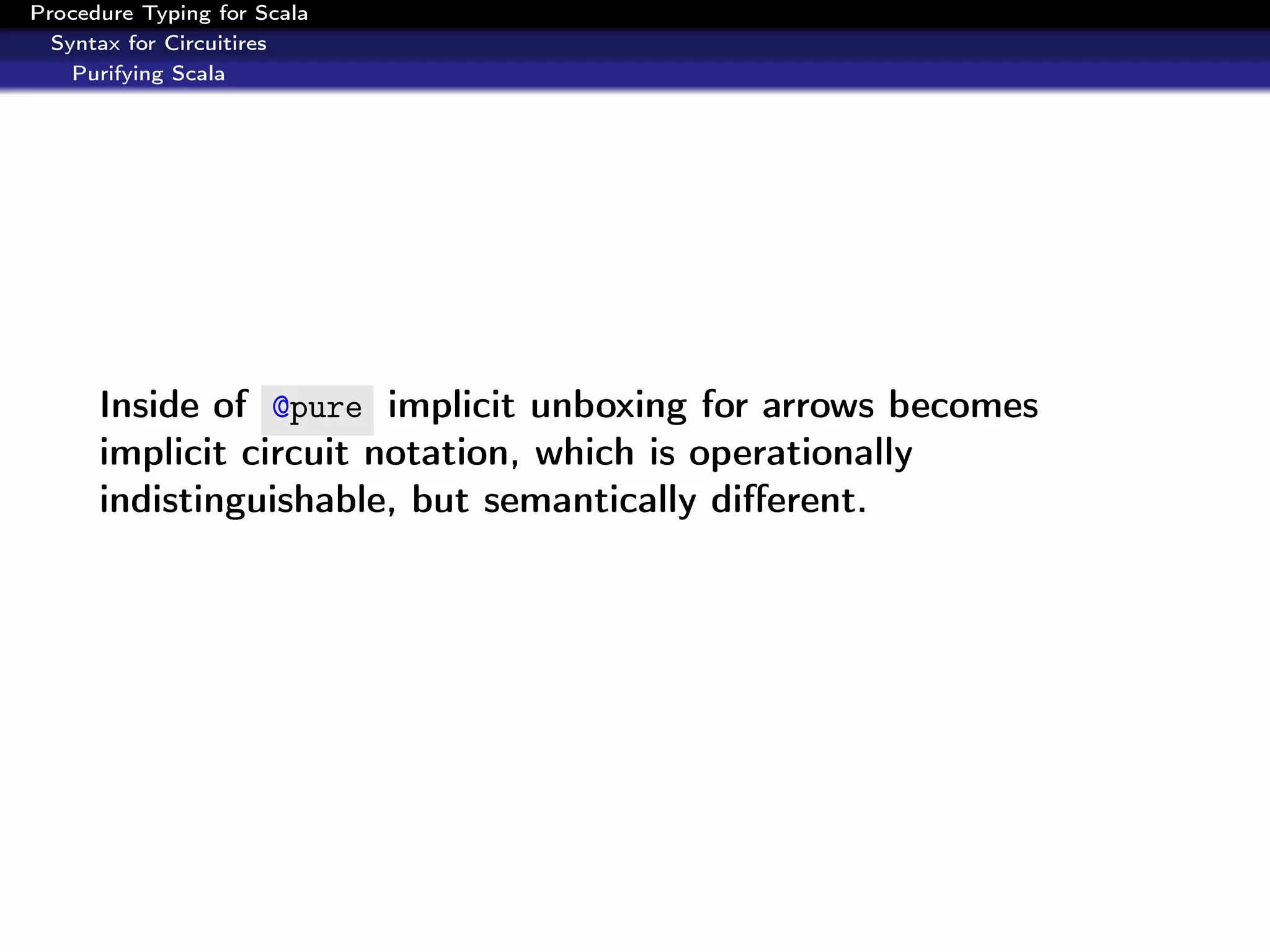
![Procedure Typing for Scala
Syntax for Circuitires
Circuit notation
Circuit notation, general idea:
– write circuitry type like =>[X] in front of a braced code block;
– the code block will be reinterpreted as a circuitry of the given
type (via macros).](https://image.slidesharecdn.com/scala-circuitries-120408102919-phpapp02/75/Procedure-Typing-for-Scala-70-2048.jpg)
![Procedure Typing for Scala
Syntax for Circuitires
Circuit notation
Example:
=>[Logged] {
f(x) + g(x)
}
Result:
(reify{x} andThen reify(dup) andThen (f affix g) andThen reify{_ + _})](https://image.slidesharecdn.com/scala-circuitries-120408102919-phpapp02/75/Procedure-Typing-for-Scala-71-2048.jpg)
![Procedure Typing for Scala
Syntax for Circuitires
Circuit notation
In presence of implicit[X] every free braced block {...}
which uses external symbols of the type =>[X] should be
treated as =>[X] {...} , an implicit form of circuit syntax.](https://image.slidesharecdn.com/scala-circuitries-120408102919-phpapp02/75/Procedure-Typing-for-Scala-72-2048.jpg)
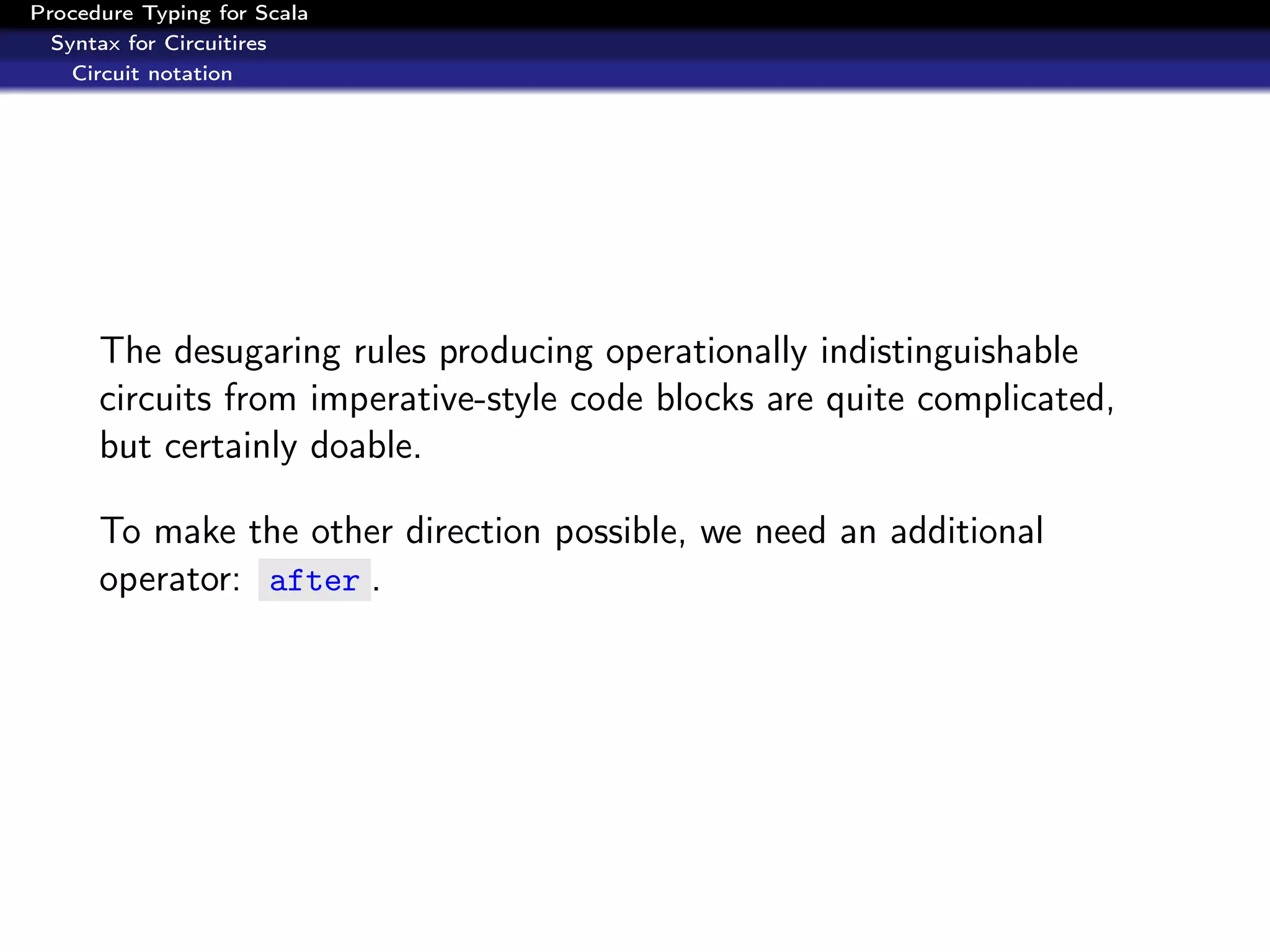
![Procedure Typing for Scala
Syntax for Circuitires
Circuit notation
Consider two arrows f: Unit => Unit and g: Unit => Unit .
They can be composed in two ways: f affix g (out-of-order) and
f andThen g (in-order).
affix in circuit notation will obviously look like f; g , though for
andThen we need some new syntax:
=>[Future] {
val n = f
after(n) g
}](https://image.slidesharecdn.com/scala-circuitries-120408102919-phpapp02/75/Procedure-Typing-for-Scala-74-2048.jpg)
![Procedure Typing for Scala
Syntax for Circuitires
Circuit notation
Without after , =>[Future] and other similar circuitries respect
only dataflow ordering, but ignore the order of independent effects
(e.g. writing into a log).
By combining usual imperative notation and after ,
any possible circuit configurations can be achieved.](https://image.slidesharecdn.com/scala-circuitries-120408102919-phpapp02/75/Procedure-Typing-for-Scala-75-2048.jpg)
![Procedure Typing for Scala
Syntax for Circuitires
Circuit notation
Now the example stated above is fully understandable:
=>[Future] {
val a = alpha(x)
val b = beta(x)
after (a | b) {
Log.info("First one is completed")
}
after (a & b) {
Log.info("Both completed")
}
gamma(a, b)
}
( after trivially supports any combinations of ands and ors.)](https://image.slidesharecdn.com/scala-circuitries-120408102919-phpapp02/75/Procedure-Typing-for-Scala-76-2048.jpg)
![Procedure Typing for Scala
Syntax for Circuitires
Circuit notation
Blocks as Objects
For the sake of composability, blocks should be treated as
anonymous classes extending their arrow type:
=>[Future] {
val result = {
@expose val partialResult = compute1(x)
compute2(partialResult)
}
after (result.partialResult) {
Log.info("Partial result ready")
}
}
The result in the after context is not just =>[Future] Int , but
its anonymous descendant with a public member partialResult .](https://image.slidesharecdn.com/scala-circuitries-120408102919-phpapp02/75/Procedure-Typing-for-Scala-77-2048.jpg)
